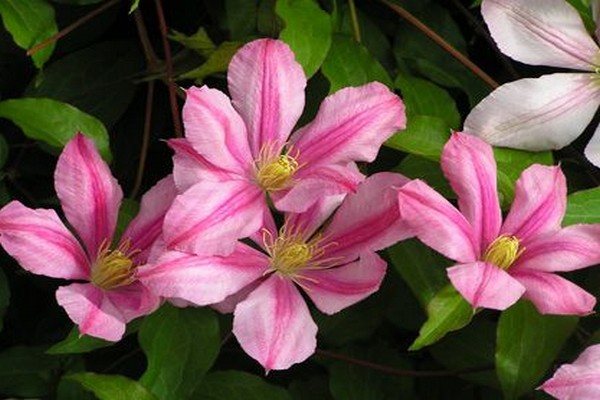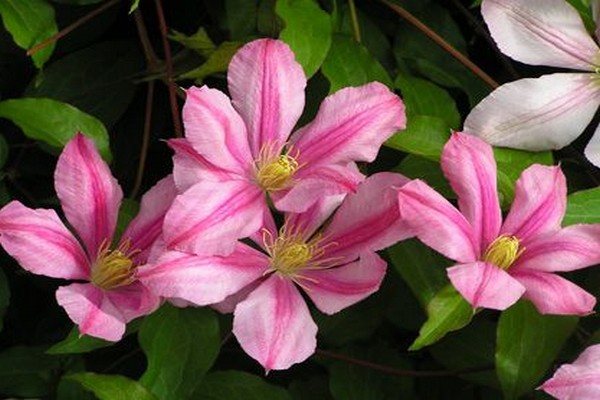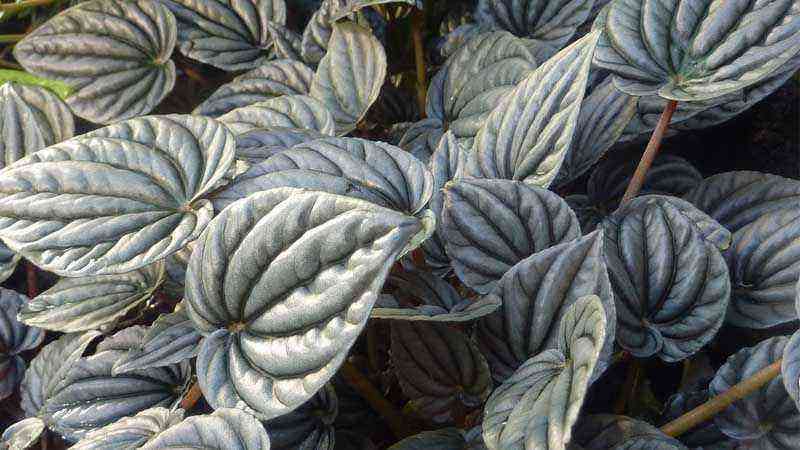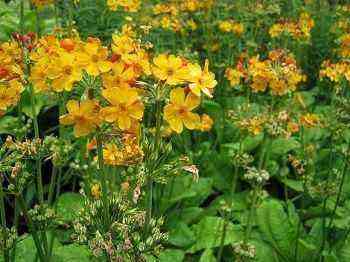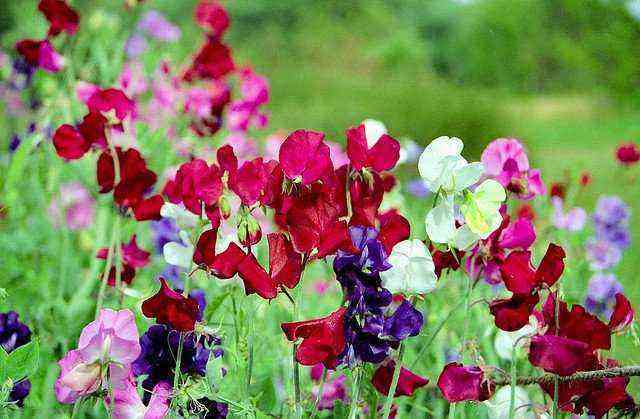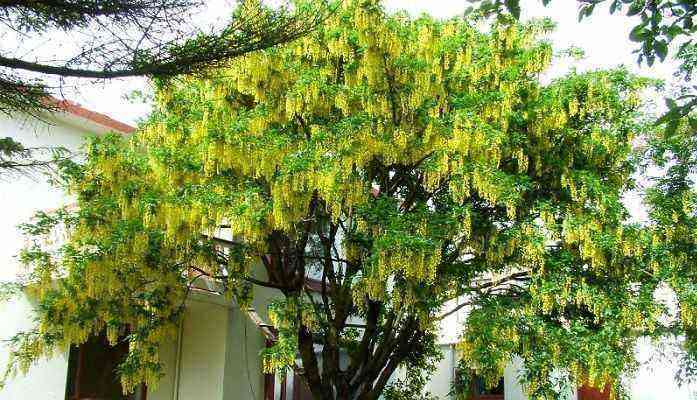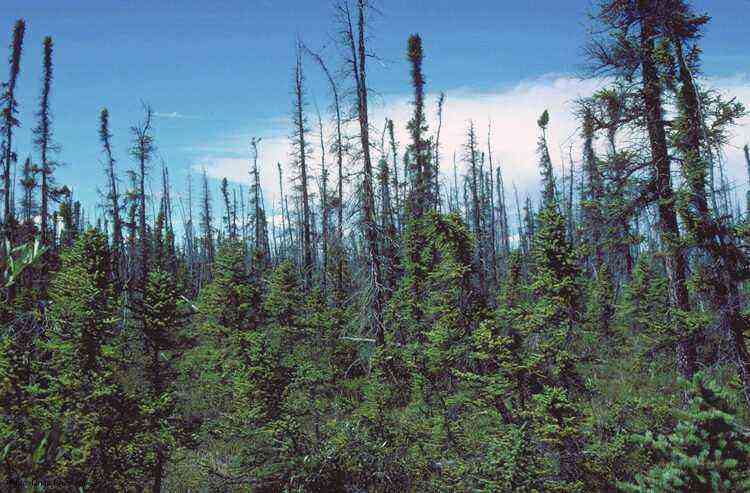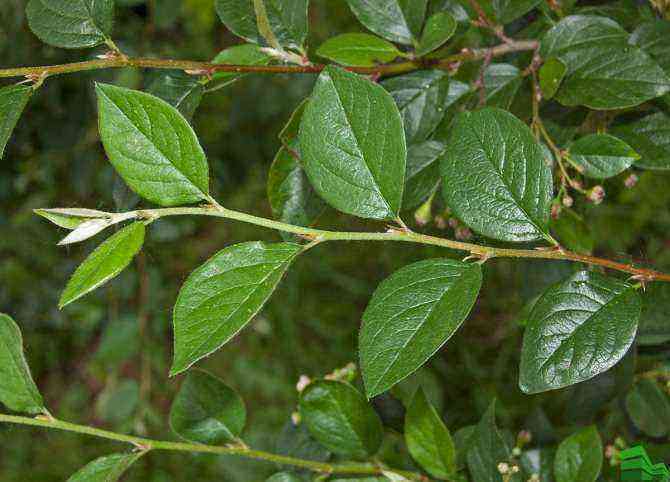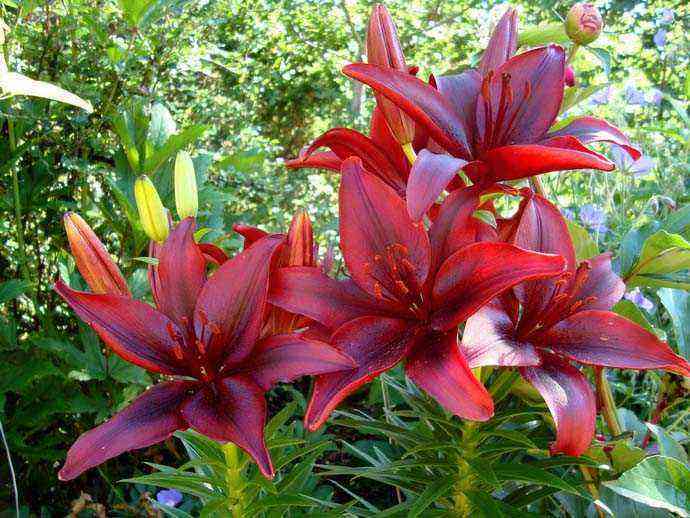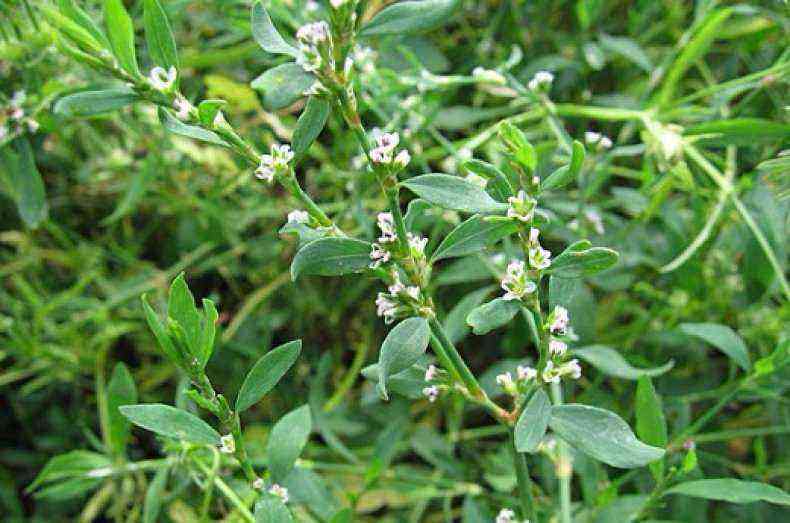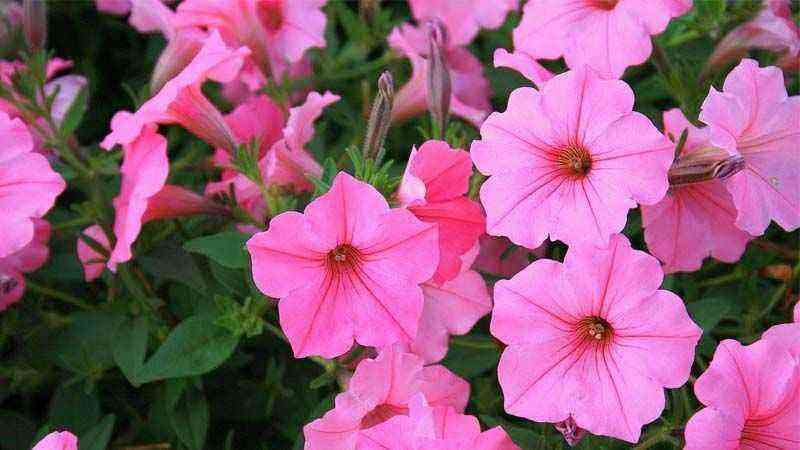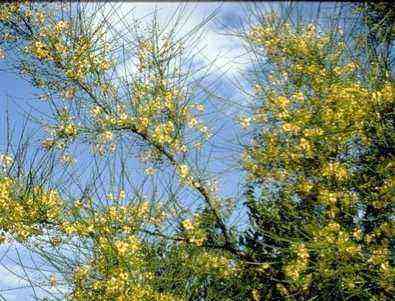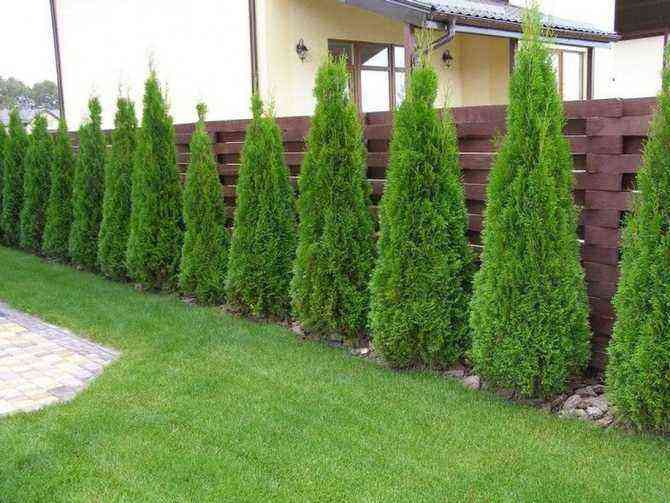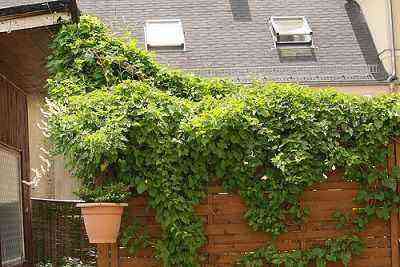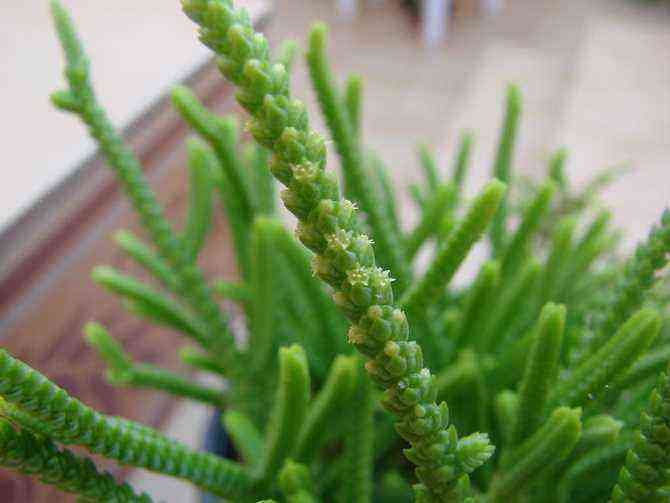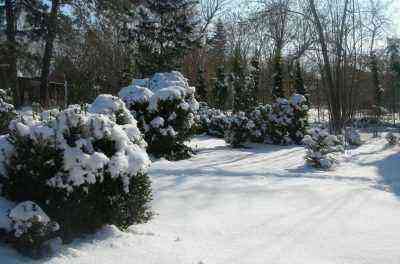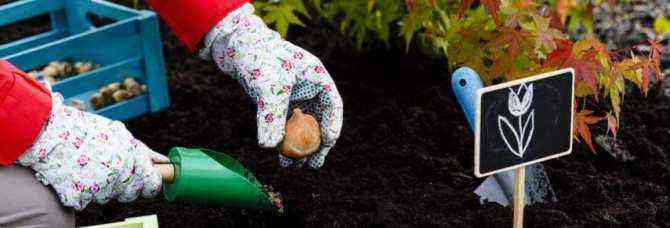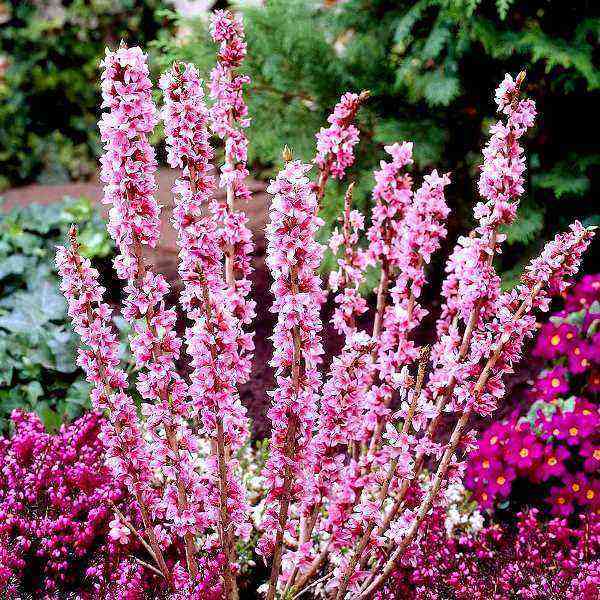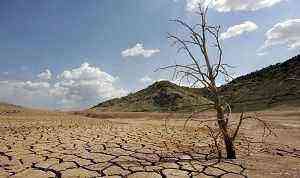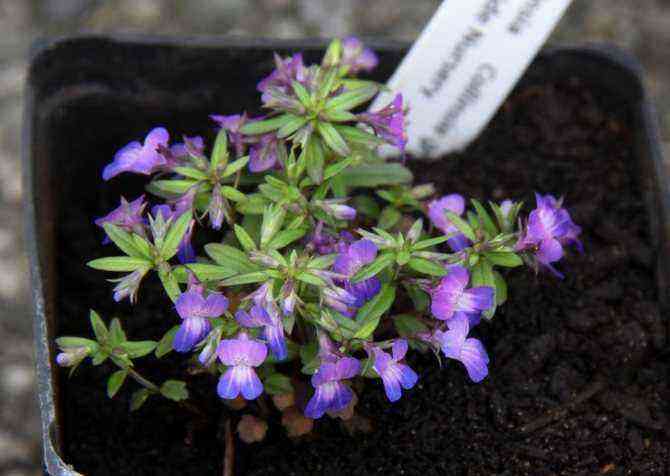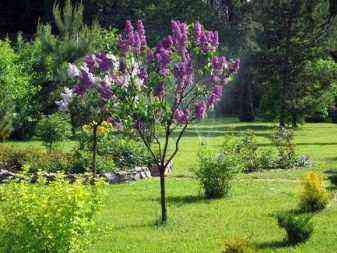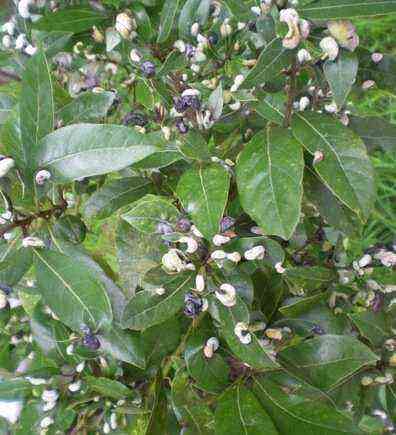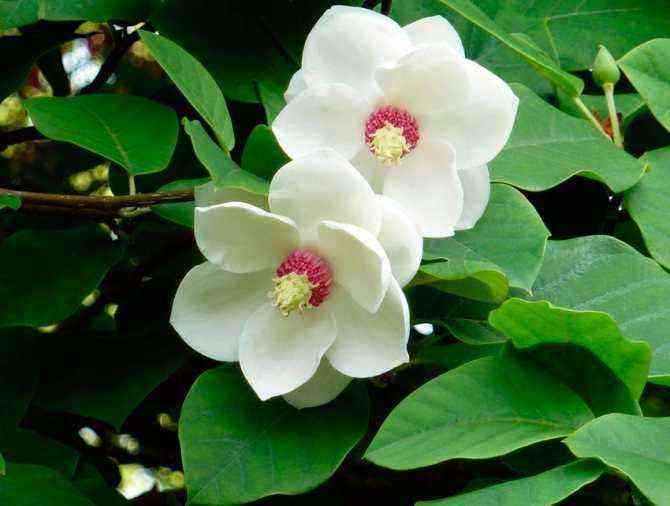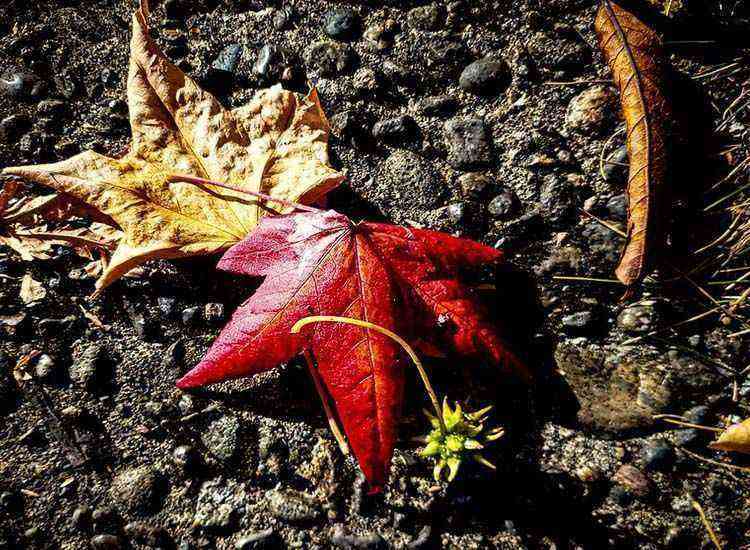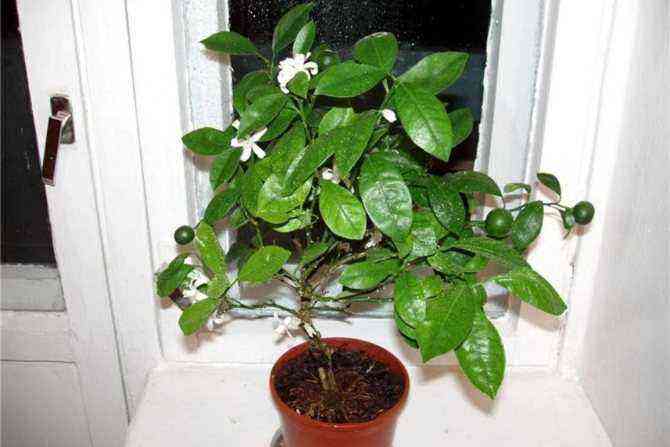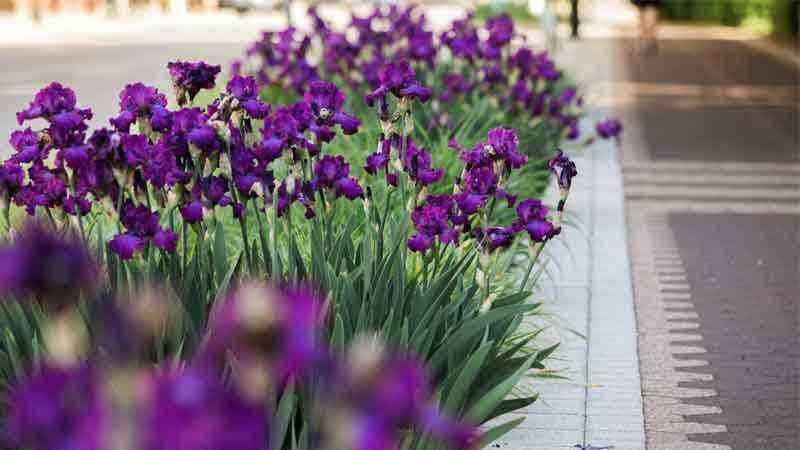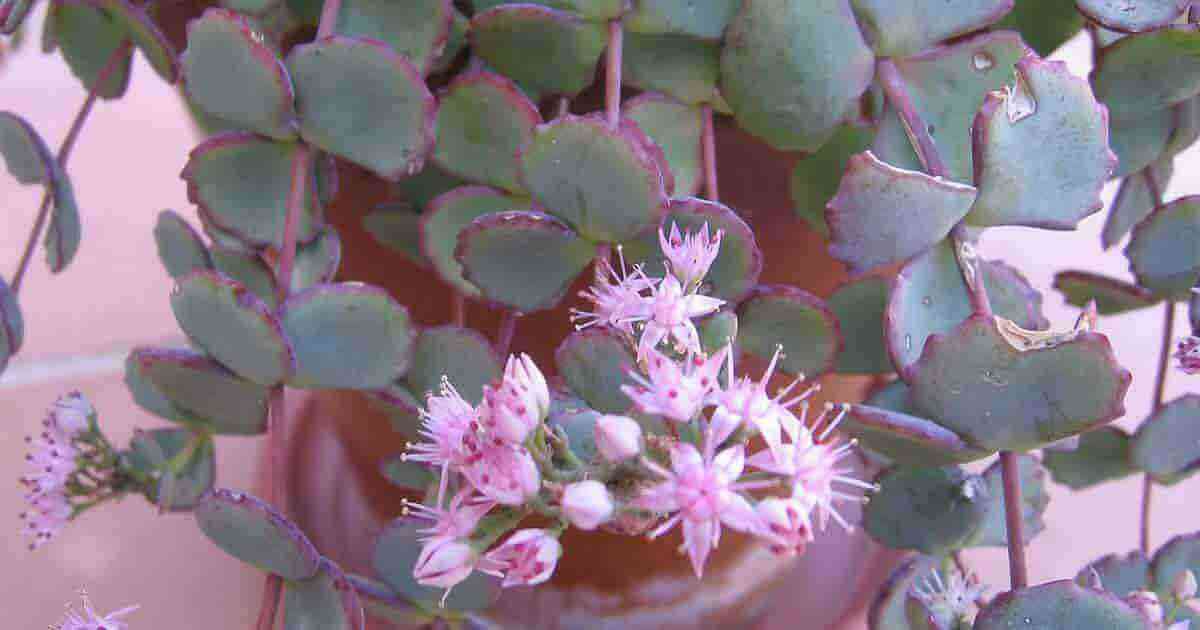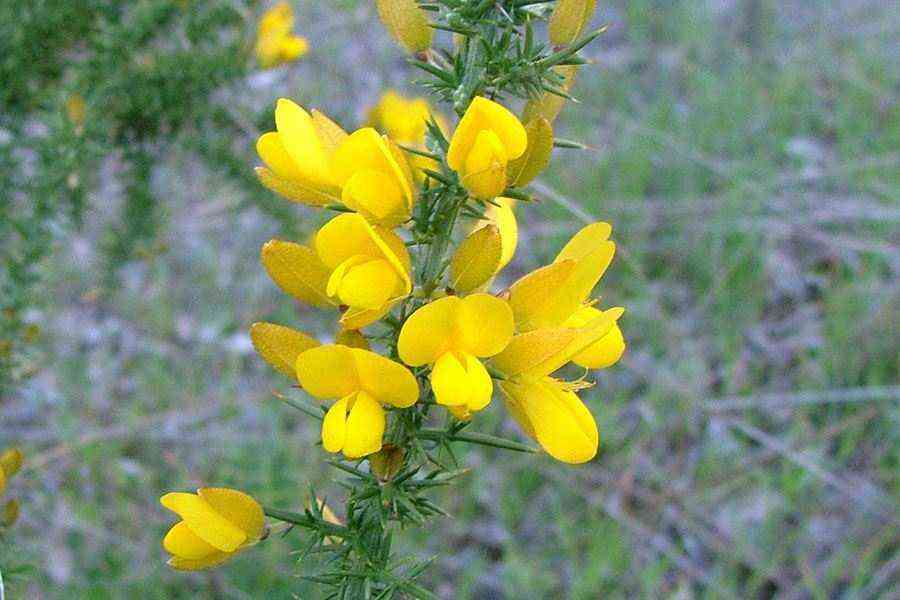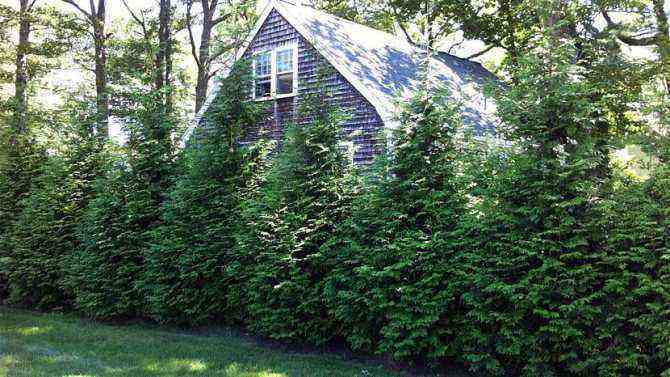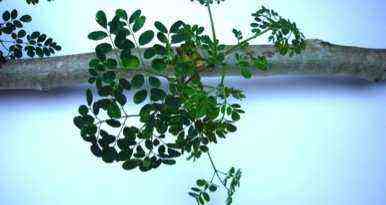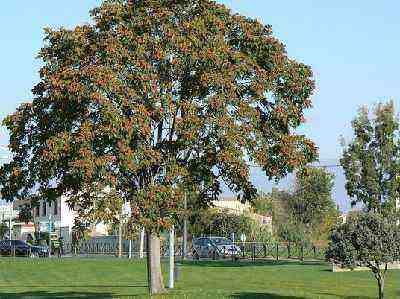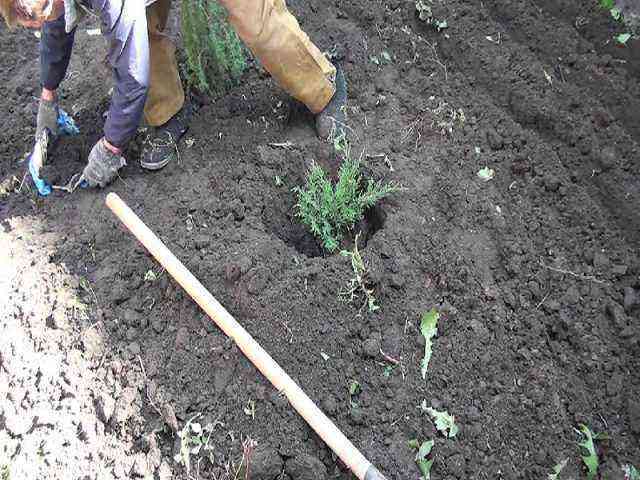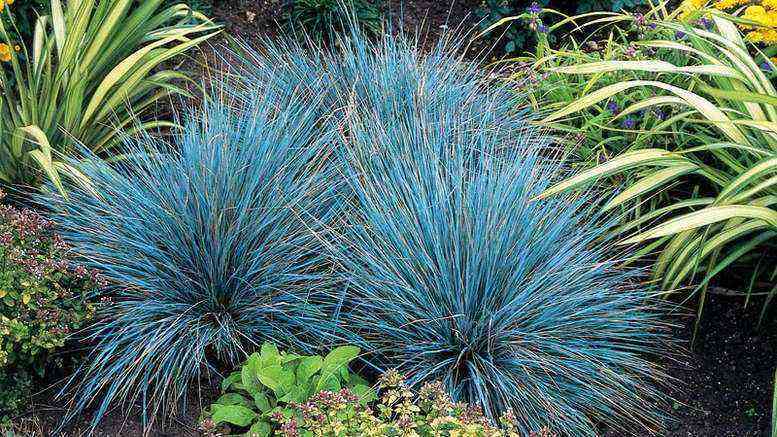Clematis – planting and care in the open field for beginners
To properly care for the planting, you need to know the main features of the plant.
Requirements for planting material
The main requirements for planting material depend on the season:
- When planting in autumn, the plants should have well-developed vegetative buds.
- In spring, the plant must have at least one shoot.
- Seedlings are used, which have three roots in length from ten centimeters.
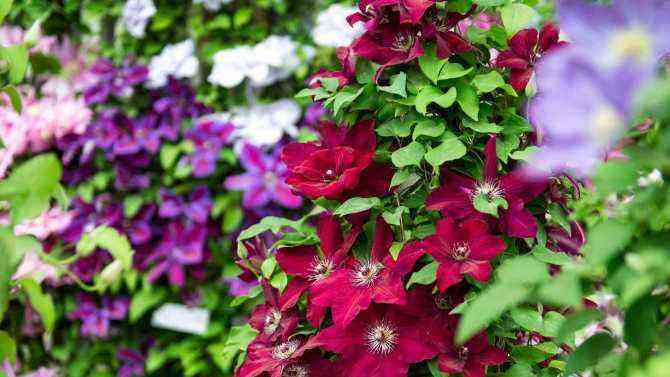
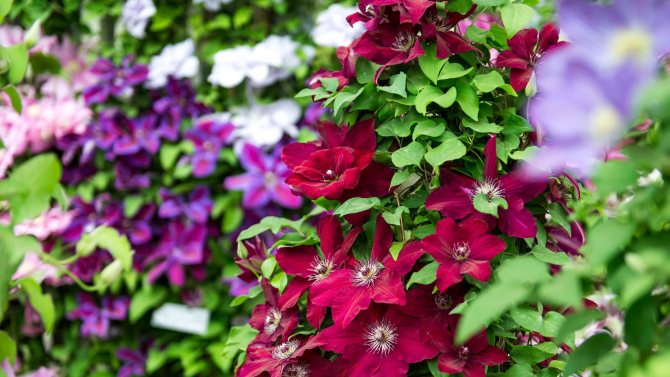
Clematis is a luxurious garden decoration
If the flower has a weak root system, it must first germinate. For this, it is placed in a special container.
Important! Before planting clematis, you need to make sure that the planting material is completely healthy. The roots are suitable only elastic, without damage, swelling or discoloration.
Saplings of clematis
How to save a seedling before planting
A plant seedling can be purchased in advance before planting. The flower is able to grow for a certain time in the apartment, but the basic rules of care must be followed:
- Clematis is located in the brightest place.
- It is regularly necessary to check its neck, if necessary, add earth.
- In order for the roots to develop better, additional shoots appear, pinch the top.
- It is important to avoid over-watering as this will cause the development of fungal diseases.
- The plant needs hardening. If it’s a warm sunny day, you can keep it with an open window.
- If necessary, clematis shoots are tied to a support.
- The plant can be fed with fertilizers intended for indoor flowers.
Following these rules before planting clematis will help you grow a strong plant. It will easily take root in the future in the garden.
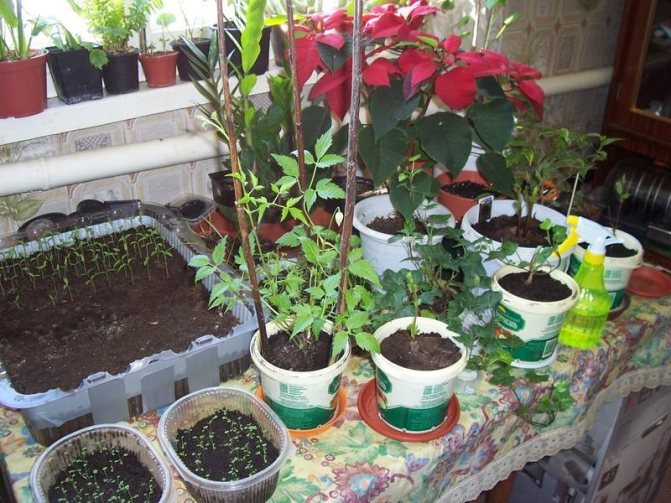
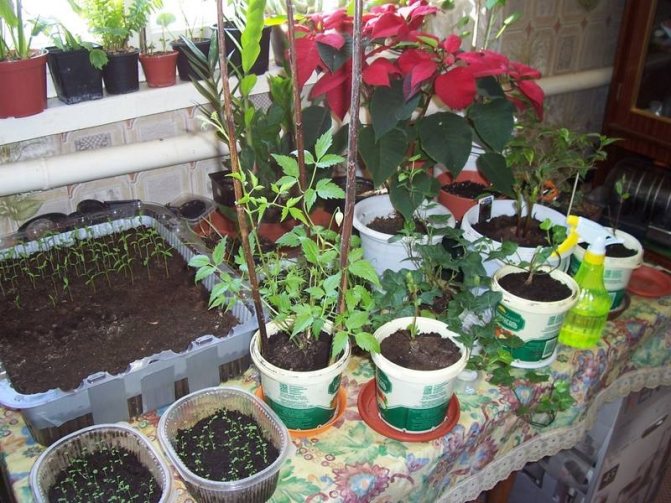
Preservation of seedlings at home
Clematis roots
The flowering of a plant, its beauty and health depends on the state of the root system. Most varieties have succulent roots. It is important to take care of their intensive development. The roots are very fond of shade, although the plant itself grows well in the sun. In this regard, it is recommended to plant low-growing shrubs next to the flower.
Important! High humidity in the soil should not be allowed, as this provokes the multiplication of pathogenic fungi.
Hybrid clematis
Vines cling to stems and leaves. Small single corollas are collected in inflorescences.
On decorative clematis, pubescent fruits of a round shape are formed. The leaf blades are juicy and interesting in shape.
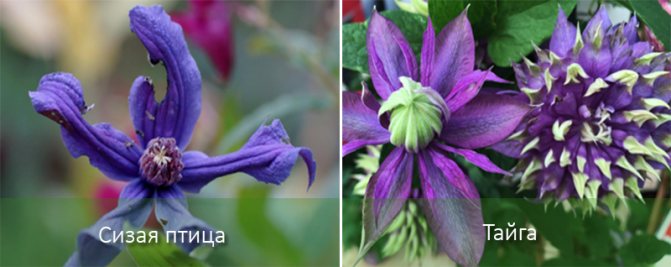

Friends! As part of our portal, we launched a book on how to make a lawn with your own hands. If this topic interests you, then READ MORE >>
These plants need strong supports. This is due to the impressive weight of adult clematis. To achieve maximum decorative effect, they are planted in areas that are protected from the wind.


Varieties of hybrid clematis with photos and descriptions
The most decorative varieties:
| Varieties | Description |
| Gray bird | Downward-pointing blue-purples. The flowering period lasts for three months. |
| Ville de lyon | Shoots are dark brown, buds are carmine red, bright yellow anthers. The flowers range in diameter from 9 to 12 cm. The opening period depends on when the pruning occurs. |
| Nellie moser | Light pink flowers, the petals of which are decorated with a burgundy stripe. Star-shaped corollas can reach 16 cm in diameter. |
| Ideal | White flowers with a diameter of 16 to 20 cm. Anthers are distinguished by anthers of a black shade. |
| Jacquemane | Yellow anthers, purple sepals. |
| Blue flame | Open flowers, distinguished by a two-tone color. Decorates the garden until mid-autumn. The diameter does not exceed 15 cm. |
| Comtess de Bouchaux | Large bright pink corollas. It has 6 petals with wavy edges. Anthers are yellow. |
| Taiga | Terry lemon-purple flowers. Can be simple or complex. |
| Manchurian | Height – 3 m. Leaf blades are opposite. White flowers consist of 3-7 petals. |

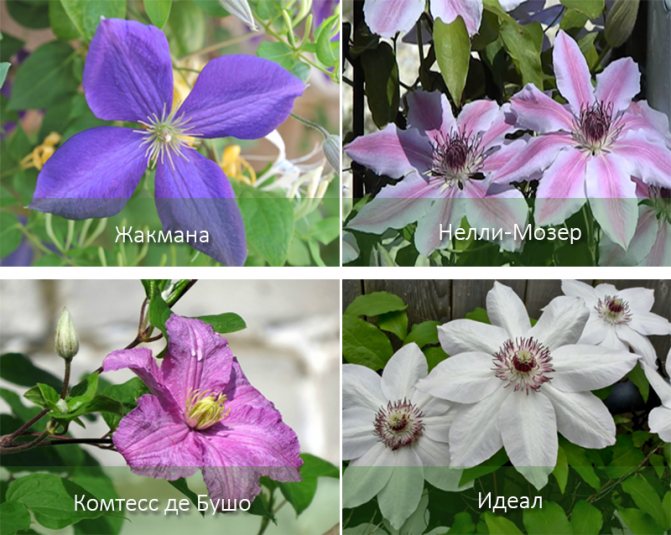
When is it better to plant clematis
Roses – planting and care in the open field for beginners
It is important to observe the correct time for planting a flower. The plant belongs to a crop with an early growing season. If you do not plant it in a timely manner, the biological rhythm will be disrupted. This will lead to the fact that the flower will not have time to take root before the cold weather.
Planting dates depend on the region:
- If the procedure is carried out in the spring, it should be done before the buds swell and break open. For the central part of Russia, this time begins from mid-April and lasts until early May.
- Clematis, which were grown in an apartment, are not recommended to be transplanted into open ground until the frost has passed. A change in temperature will be detrimental to the plant.
- If the planting falls in the fall, it should take place no later than at the end of August. This will help the plant to root before frost.
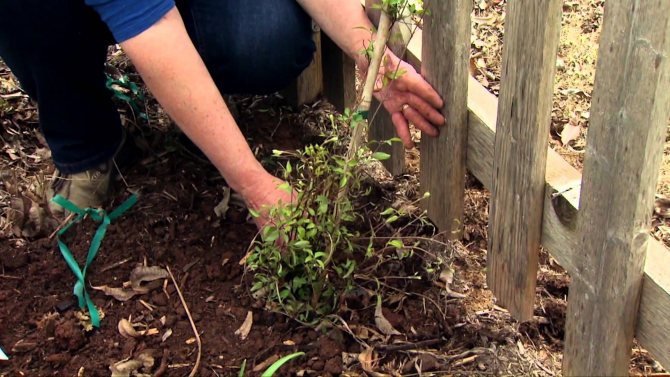
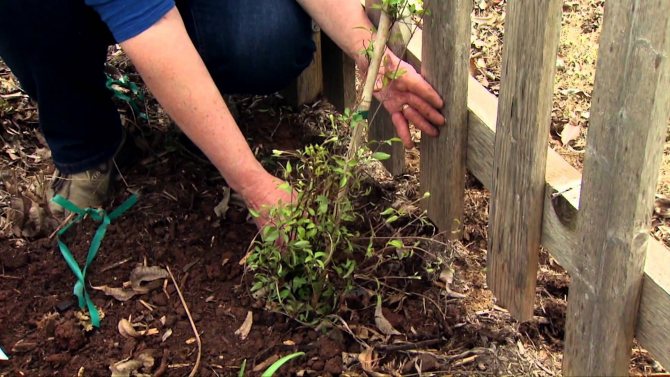
Disembarkation rules
In summer, you can plant clematis with a closed root system. To do this, choose a cloudy day. For the winter, the plant is transferred to a greenhouse or apartment, where it grows until it can be transplanted into open ground.
Important! If a rooted stalk is purchased in a store, packed in a bag with a peat mixture, it should not be planted in open ground. In the first year, it can only be grown in a deep container, removed for the winter in a warm place. Only the next year, the seedlings are moved to open ground to a permanent place.
Features of planting clematis in the autumn season
Gardeners consider autumn to be the best time to plant clematis. The plant manages to strengthen the root system before the beginning of winter. The most optimal soil and air temperature for planting is observed in September.
Despite the fact that many varieties of flower have been bred that tolerate frost perfectly, the autumn plant requires special care. To prepare it for wintering, you will need to carry out a number of activities:
- Young seedlings must be covered for the winter. This can be done both with dry leaves and with branches or improvised material, for example, a film, roofing material.
- No later than October, the bushes are fed with a mixture of humus and ash.
- Watering is stopped in the fall. It is important to follow this rule, as with night frosts, moisture will destroy the roots.
- Bushes that are already one year old are completely freed from dry foliage and pruned. Only the trunk up to 30 centimeters long remains.
- After pruning, clematis is spud up, then covered with branches and film.
Important! If the plant has long shoots, it is folded, wrapped with material, laid on the ground and covered with roofing material. This will protect the roots from moisture.
Features of planting clematis in spring
Most clematis varieties are recommended to be planted only in spring. Liana needs time to root properly and prepare for winter. A perennial plant planted in spring will develop a good root system before frost, allowing it to grow for at least twenty years.
Spring planting has its drawbacks. It is important to meet the deadlines, since the bush starts growing very early. If you plant a plant with bare roots and blooming buds, it will react sharply to the smallest damage. Therefore, it is important to have time to plant it before bud break.
Reproduction of clematis
New clematis are obtained by means of seeds, cuttings, cuttings and young shoots. Seed material is most often used for breeding purposes.
When purchasing seedlings, it is recommended to pay attention to:
- mechanical damage;
- root condition;
- developed shoots with buds;
- purchase time.
Cultural varieties of clematis are propagated by grafting into winter-hardy varieties.
Division of the bush
The procedure is carried out if the age of clematis does not exceed 6 years. Otherwise, difficulties provoked by the overgrown root system cannot be avoided.
The procedure is pretty simple:
- dig up a liana;
- rid her of the earth;
- cut that part of the plant on which there are basal buds.
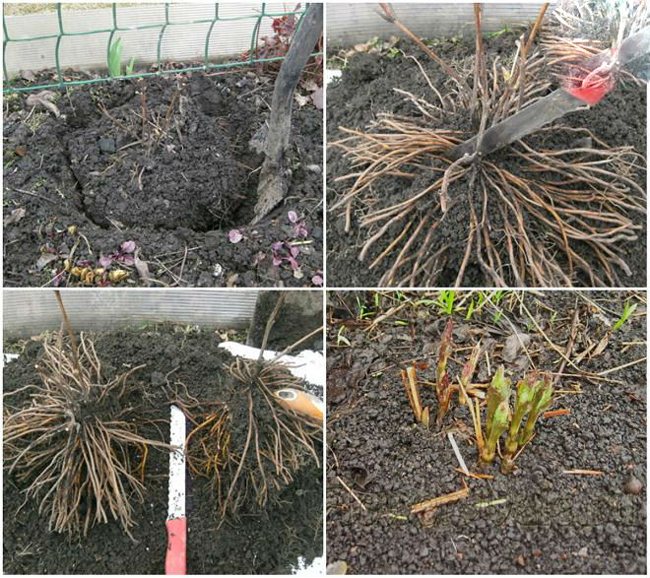
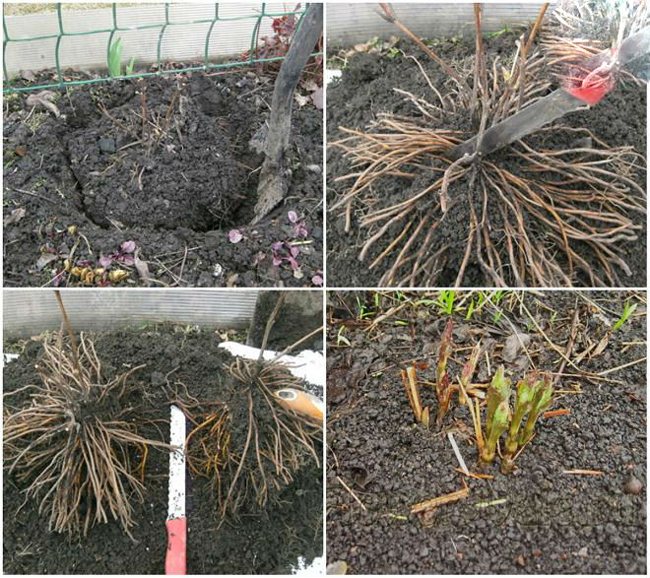
The division must be carried out in the fall or spring. If the bush is too large, it will be enough to separate only part of the crop.
Layering
The process of their separation and transplantation is not difficult. By this method, you can get no more than 10 seedlings.
The method is used in the autumn period. Thus, the formation and strengthening of clematis is accelerated.

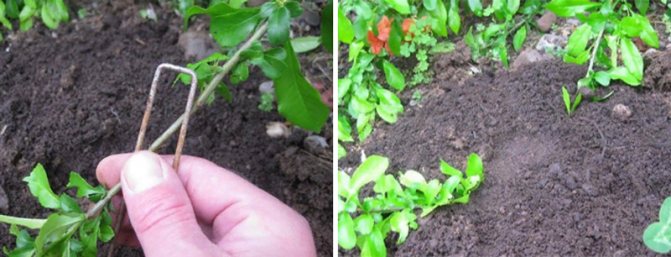
The grower must follow the algorithm:
- grooves are made around the plant, the depth of which is 10 cm;
- choose shoots;
- remove foliage;
- fix the internodes;
- fall asleep parts of the plant of fertile soil.
The result of the work is a bed on which the tops of the layers peep out by 20 cm.
Cutting
The procedure is carried out with budding. Biostimulants accumulate in the shoots of clematis. To increase the likelihood of root formation, short lateral processes are used.
After complete cutting, they are divided into processes, each of which should have one node. Particular attention should be paid to the direction of the cut: the upper one is made straight, the lower one – oblique.


Step-by-step instructions for planting clematis in spring
Garden hydrangea – planting and care in the open field for beginners
Knowing the sequence of how to plant clematis correctly will help you grow a gorgeous plant in your country house.
Soil and planting rules
Soil preparation should be done in advance. This is necessary for the earth to settle. It is best to hold the event 1.5 months in advance.
What kind of soil does clematis like?
The plant prefers a nutritious and loose soil that quickly absorbs excess moisture. You can not plant a flower in the ground with high acidity. This will lead to his death.
It is important to check the moisture level when choosing a planting site. The plant does not tolerate abundant groundwater. Experienced gardeners recommend preparing artificial mounds for the comfortable growth of clematis. To remove moisture, grooves are made and covered with sand.
Planting pit preparation
Before planting the plant, the site is cleared, garbage, stones, weeds are removed. If the soil is acidic, it must be neutralized. For this, the site is dug up, wood ash is added to the ground at the rate of 200 g per square meter.
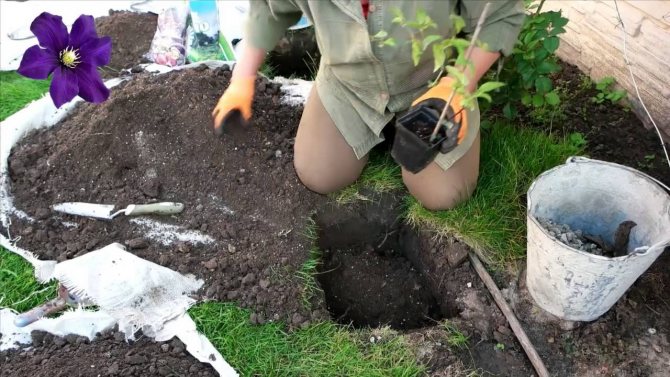
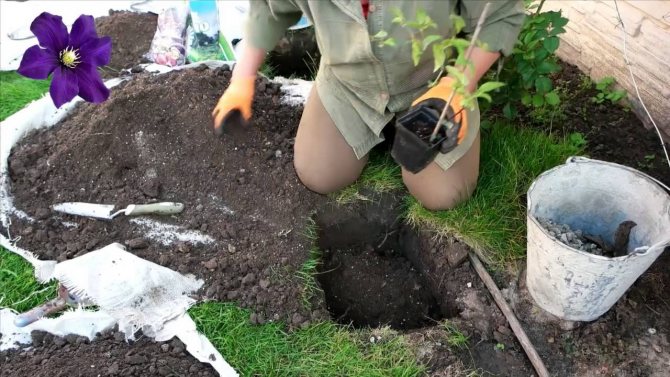
Pit preparation
Stages of preparing the landing pit:
- You need to dig a hole 60 centimeters deep.
- Lay a drainage layer of 15 cm at the bottom. It can be expanded clay, gravel, pebbles.
- Fill the hole two-thirds with a mixture of river sand, peat, humus and sod land. You can add 150 g of mineral fertilizer.
- Then water the soil abundantly so that the soil and fertilizers can settle.
Important! It is best to leave a distance of one meter between the bushes. If the gardener wants to organize a dense flower bed, you can plant clematis at a distance of 30 cm from each other.
Choosing a place and preparing for planting clematis in open ground
When choosing a place, you need to take into account that the plant does not tolerate high humidity. It is necessary to avoid wetlands, stagnant water, runoff from roofs. This leads to the development of fungal diseases in the plant.
The area under the tree is not suitable for clematis. Both the bush and the tree have large roots, they will begin to pull nutrients from the soil from each other.
Clematis flowers grow well in sunlight, but the roots prefer shade. In this regard, it is best to plant ornamental grass next to it.
Planting technology for clematis
The breeding process, the timing of when to plant clematis, can be traced according to the diagram:
- The fertilizer pit is compacted.
- If a seedling with an open root system is used, then a mound is made in the center. The plant is placed on it, the roots are straightened in a circle.
- Seedlings with a closed root system are placed in the center of the pit.
- The root collar is covered with earth by 10-15 centimeters. Several buds should be hidden by the soil.
- A small groove is made around the trunk for easy watering.
- After planting, the bush is well watered, a peg is placed next to the hole, to which the seedling is tied.
- Mulching is carried out with peat or sawdust.
After planting, arcs are established around the plant, then you need to cover the plant for several weeks with agrofibre.
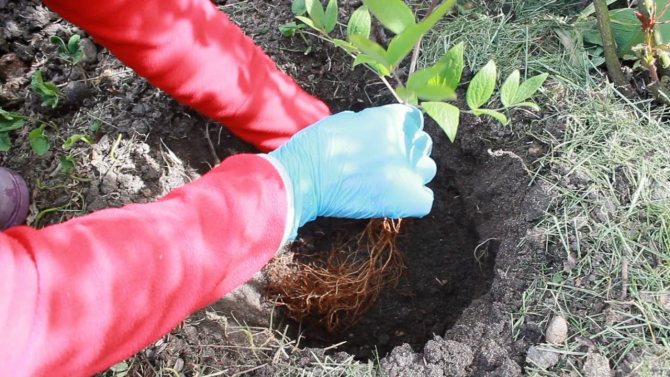
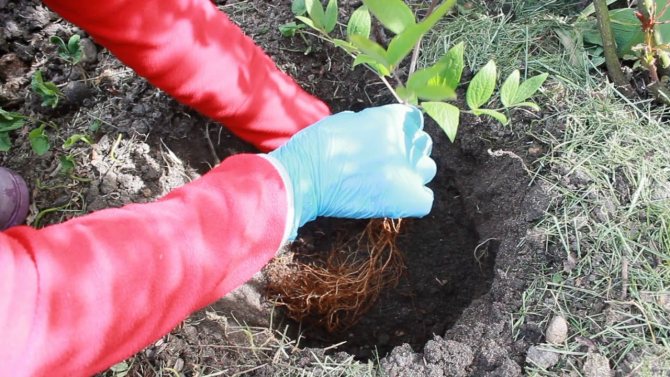
Clematis planting technology
Species clematis
The plant does not take up much space. Additional garden tools are used for support. Their configuration may vary.
Obelisks, walls, stairs, trellises and arches are made of wood and metal. For cultivation, meshes are used, divided into square cells.
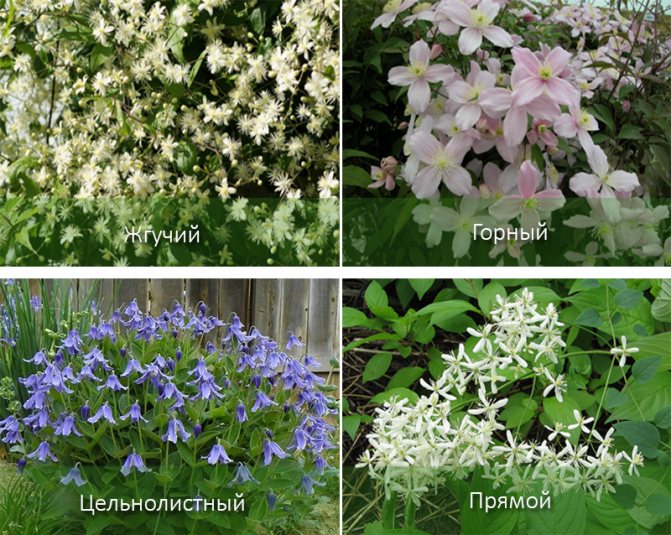
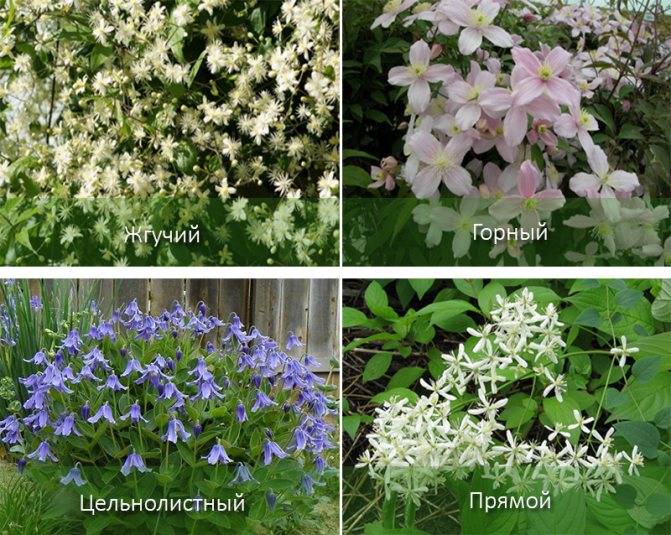
The most common varieties are:
| View | Description | Flowers / varieties |
| Straight | Height – up to 1.5 m, erect stems, decorates the garden from May to June. Gives self-seeding, there is a need for support. | Small white corollas, 1 to 1.5 cm in diameter. |
| Whole-leaved | Height – from 0.6 to 1 m, silvery fruits are distinguished by a spherical shape. Straight stems must be tied to low devices. Blooms in early summer. | Single purple, petals bent outward.
|
| Tangut | Lianas (length not more than 4 m), fruits are decorative, support is needed. | Yellow broadly bell-shaped. |
| Alpine | Height – 3 m, large leaves with a leathery coating. It begins to bloom in August. |
|
| Flamboyant (Florida) | The length can be more than 3 m, an impressive scent. Compact flowers. Frost resistance, no fear of sunlight. |
|
| Mountain (Montana) | Height – 9 m, sharp and small leaves, which are collected in bunches. Delicate aroma. |
|
| Purple (Viticella) | Corollas are simple, the length of the shoots is 3.5 m. The flowering period is from June to September. Leaves of a complex type. |
|
| Burning | They are characterized by rapid growth, the length of the shoots is no more than 5 m. Complex leaf blades of a dark green hue. Blooms in the middle of summer. | Small white corollas are collected in inflorescences. |
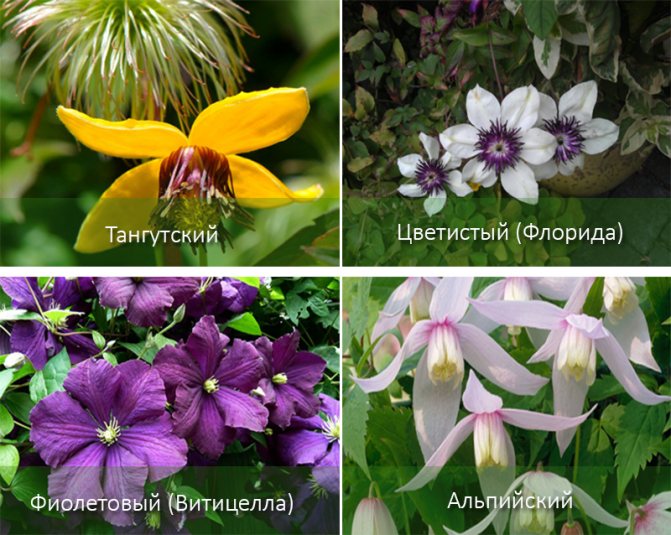

Clematis: general rules for care and cultivation
Caring for clematis does not require much effort. The plant needs it only in the first year after planting.
Clematis care in the first year
Irises – planting and care in the open field
After planting, the flower is under stress, it needs help in getting used to the soil. It is important to create shading until it takes root. For this, arcs are installed from the sunny side and agrofibre is pulled.
There are a number of recommendations on how to care for clematis in the first year:
- After planting the plant in open ground, you need to carefully monitor the level of soil moisture. Overflow should not be allowed, but drying out is dangerous for the flower. Water it once every seven days. If the weather is very hot, the procedure is increased up to two times.
- The area around the plant should be mulched regularly. This will help keep moisture in the soil and protect the roots from overheating on hot days.
- Experienced gardeners recommend planting marigolds next to the bush. They are able to protect clematis from pests.
- After each watering, the soil around the plant must be loosened. This will open up oxygen access to the root system, improve the structure of the soil.
- It is important to remove the weeds immediately.
- In the first year, the plant in the open field must be pruned. This is done in the fall, all shoots are cut off, only 30 cm is left above the surface.
Important! In order for the flower to winter properly, it is important to take care of its shelter. This is done just before the frost. Shelter is especially important in the Moscow region, in the Urals, in the Leningrad region, in Siberia.
How clematis grows
The plant creeps up. It is due to this growth method that it attracts gardeners. With clematis, you can create magnificent arches in your garden. For proper growth, the flower needs support. For this, both a chain-link mesh and pillars with a stretched wire are suitable.

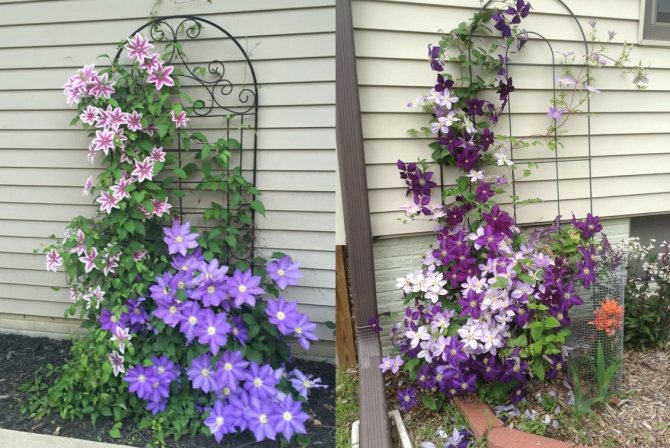
Clematis support
You can choose several types of flower supports:
- arches;
- pyramids;
- cylinders.
Thanks to such supports, you can create beautiful designs, support the stems. It is important that the material is strong and can withstand a heavy plant.
Duchess of Edinbourgh
This clematis is a real aristocrat. It is no less majestic than its name, which translates as “Duchess of Edinburgh” (and the bearer of this honorary title is none other than Queen Elizabeth II herself). It is impossible not to fall in love with the lush terry inflorescences of a snow-white shade with a pale yellow center.
This clematis is frost-hardy, good and fast growth. Flowers on the shoots of the last year are double, on the shoots of the current year they are simple.
| Plant height (cm) | Color of petals | Flower size | Trimming group | Terms of flowering |
| 200-300 | White | Large | 2 | May June July August |
How to properly care for clematis
In order for the plant to be lush, to have a beautiful shape, the subsequent care of clematis must be timely. It is important to pinch and tie it correctly.
Features of watering
Waterlogging is harmful to the flower. In this regard, do not water it too often, the only exception will be dry and hot weather. The procedure is required once a week in the first year of the plant’s life.
From the second year, the bush is watered every ten days. To check if the plant has enough water, you can dig in the soil. If it is dry by 25 cm, this indicates a lack of moisture.
Fertilization chart
One of the important conditions for proper care of the bush is soil aeration. It needs to be loosened after each watering. This activity can be replaced by mulching with old manure.
Very important! Fresh manure must not be used!
The flower needs fertilization. The need increases with the growth of the plant. Top dressing should be done every two months. The amount of fertilizer depends on the size of the plant. A large adult bush will require a bucket of mortar.
In the process of feeding the plant, you need to alternate organic and mineral complexes. Organics are used only in diluted form. To feed the roots, you can use urea, diluted in a ratio of 3 liters of product per liter of water. In winter, only wood ash is used.
Nutrient deficiencies can be detected by the following:
- Shoots are shortened, new leaves appear very small. The color becomes less vivid. This indicates a shortage of nitrogen fertilizers. They are introduced in the spring during the growing season.
- Acquisition of purple leaves. The plant becomes weak, hard to tolerate frost. You can fix the problem with phosphate fertilizers.
- If the plant’s leaves and buds turn black, it lacks potassium. In such a situation, fertilizing with potassium nitrate is required in spring and summer.
Over the summer, clematis is able to release a large number of shoots and leaves. Therefore, in the first year, additional nutrition for the bush is very important. You need to feed the flower twice a month using liquid fertilizers.
The first feeding should be carried out in the spring during the emergence of shoots. it is best to use ammonium nitrate at the rate of 1 tablespoon per 10 liters of water.
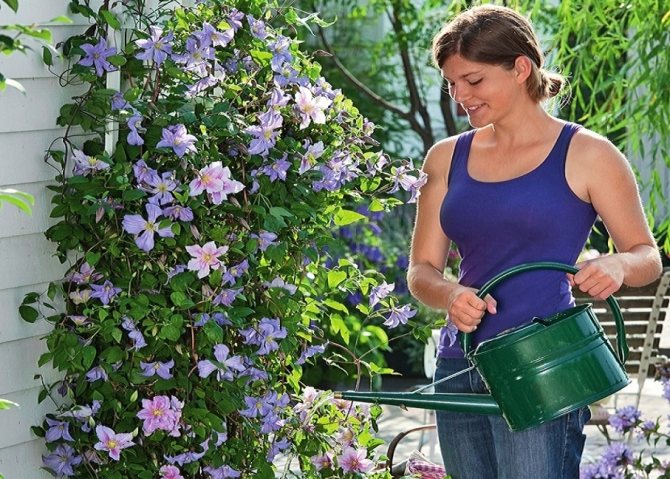
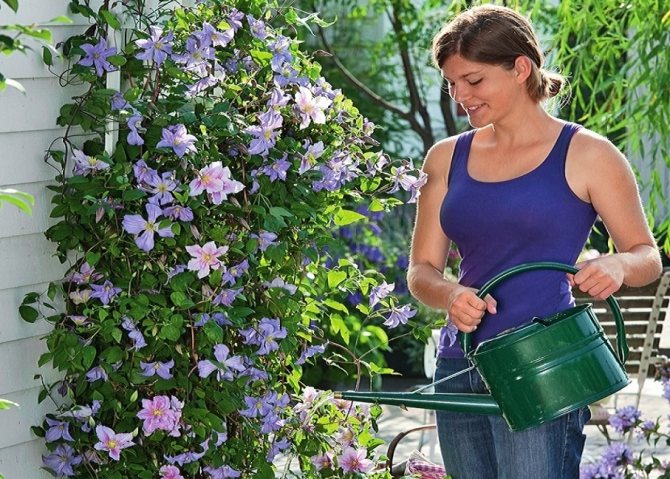
Fertilizing clematis
What clematis love for lush flowering: the tricks of experienced florists
For active flowering, many gardeners use growth activation products. In addition, it is important to open the insulation on time after wintering. This must be done as soon as the snow cover has melted. If you miss the time, the shoots will intertwine with each other and break when the plant opens.
How to care for a crop after flowering
After the mass flowering has passed, you need to carry out a comprehensive fertilization procedure. Top dressing during flowering is not done, as this reduces the flowering time.
How to grow clematis from seeds
Seed propagation is the best way to create a new hybrid. This is a lengthy process. There are three groups of clematis with different seed sizes and germination times:
- large seeds germinate from 2 to 8 months;
- for medium-sized seeds, the germination rate ranges from 2 to 6 months;
- small seeds have shorter germination rates – ½ – 4 months.
It is better to use fresh seeds, but those stored in previous years are suitable. They are stored in paper bags at a temperature of 18-23 ° C. Small grains are sown in March or April, medium ones – in winter, and large ones – in autumn or early winter.
First, the seeds are soaked in water for 10 days, but change it 4-5 times daily. Then they are sown in containers with soil consisting of an equal amount of earth, humus and sand. Ready-made soil mixture for flowering plants is suitable. The seeds are not laid out thickly in a moistened substrate, lightly sprinkled with sand. The container is covered with glass or wrapped in cellophane, periodically ventilated. Optimum temperature conditions are 25-26 ° C. Moisten the soil mixture.
After the appearance of the first shoots, the containers with seedlings are rearranged in a lighted place, it is possible on the windowsills of the eastern windows. Seedlings dive into separate pots when 2-3 true leaves grow in them.
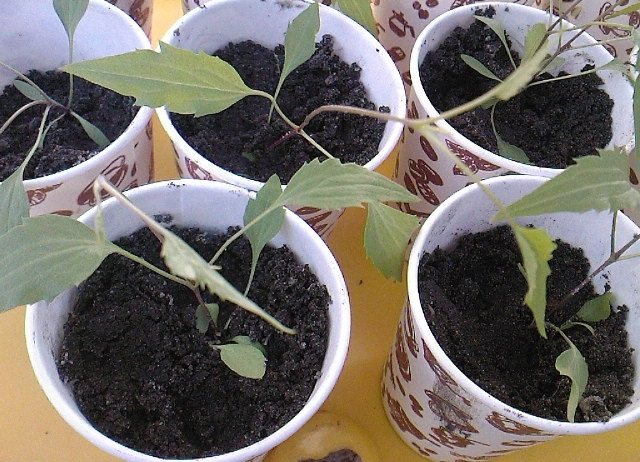
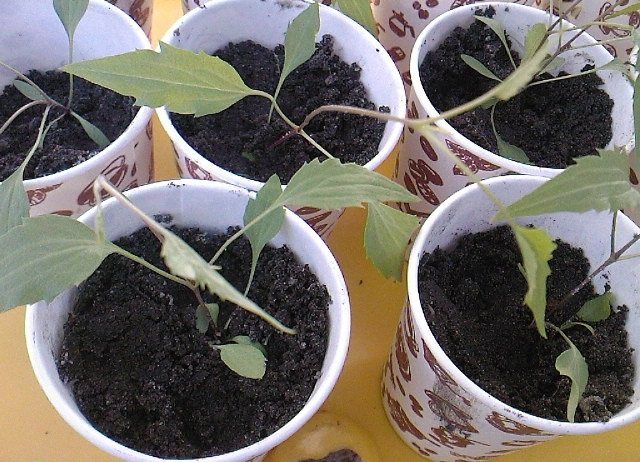
Fortified seedlings for growing are planted in open ground in a shaded place after 15-20 cm. It is recommended to periodically pinch to strengthen the roots and strengthen the branching of the plant. In the fall, the seedlings are insulated, and in the spring they are again transplanted into prepared trenches. The root collar of the seedling is deepened by 5-7 cm. The distance between them is 0.5 m. Full-fledged seedlings are obtained in 2-3 years. Then they are planted in a permanent place.
Diseases of clematis and their treatment
The most dangerous pathology for clematis is wilting. This is a pathology that manifests itself in the drying out of branches. If the plant gets sick during the growing season, this leads to its death. To prevent the problem, it is necessary to ensure that the roots are properly nourished.
Flower diseases also include:
- Spotting is the formation of fungi carried by snails. Brown spots appear on the leaves, causing necrosis. Leaves begin to fall off. Treatment is carried out with copper sulfate.
- Powdery mildew is a pathology that affects the ground part. Growth and flowering cease, the branches are covered with bloom, the plant gradually dies. Salicylic acid is used for treatment.
Of the pests of clematis, nematodes, spider mites and scale insects are terrible.

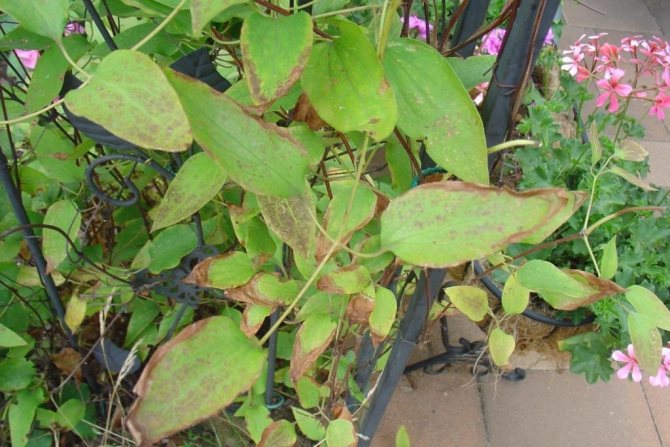
Plant diseases
Why does clematis not bloom
The lack of flowering can be observed for various reasons. This can happen if:
- the bush is planted in the wrong place;
- too wet soil;
- a diseased seedling was used;
- there are not enough nutrients in the earth;
- there are a lot of weeds around the bush;
- when circumcision rules are violated.
The lack of flowering can be due to several reasons.
Important! In the first year, the plant does not bloom.
Features of care
The main care for clematis is timely sufficient watering and feeding.
Watering
Watering clematis is necessary at least once a week. During the summer heat, its frequency increases up to 2–3 times. At the same time, 1-2 buckets of water are enough for a baby bush, while for an adult – from 2 to 4. To reduce the frequency of watering several times and slow down the growth of weeds around clematis, filling the soil with a layer of mulch (peat, moss, humus) will help. If this is not done, you should regularly (the next day after watering) loosen the soil, simultaneously breaking through the weeds.
Fertilizer
It is also important to know that in different periods you need to use certain types of fertilizers:
- nitrogen-containing – during intensive growth;
- potash – during the formation of buds;
- phosphoric – after flowering.
In the summer (after pruning), the plant is fed with a solution of complete mineral fertilizer (20 g per 10 l of water) and copper solution. Every spring, the bushes must be watered with lime milk (dolomite flour and chalk). During the flowering period, all feeding is stopped so as not to drown out the activity of the plant itself.
In order to protect the roots from rot during frequent summer rains, the bottom of the trunk should be covered with wood ash.
Supports
There are several types of supports for vines (arches, pyramids, fan structures, cylinders), each of which is perfect for clematis. The supports allow for beautiful compositions and support the plant stems. Another requirement is the strength of the construction material, which could withstand the weight of the rapidly growing and weighted moisture after rains of clematis greenery.
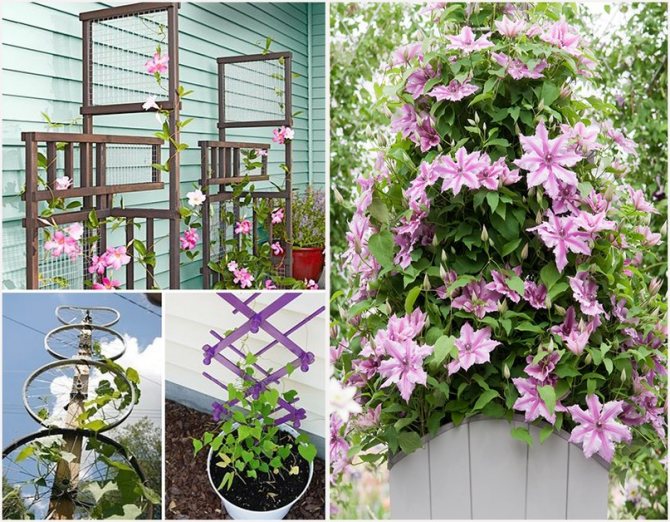
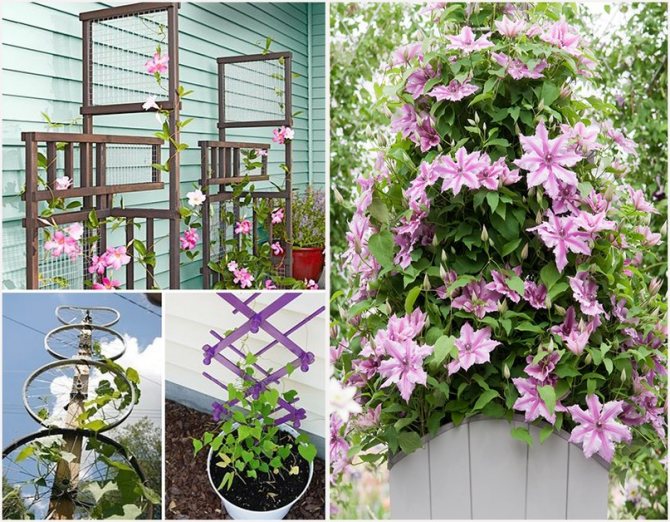
The main thing is that the place of attachment of the stem to the support is not thicker than 10-12 mm
Trimming
The correct formation and beauty of the bush depends on this procedure. Pruning is carried out several times a year:
- when planting (to form the crown and root system);
- in spring (to increase the flowering period);
- in summer (regulating pruning);
- before wintering (taking into account the features that each species requires).


The tillering ability is a characteristic feature of clematis.
Preparation for winter
Before wintering, it is necessary to remove the leaves from clematis, cut off the spoiled and dried branches. After that, remove it from the support, lay it on the ground and cover it using dry grass and leaves, straw, sawdust.
Another option is the construction of a wire frame around the plant laid on the ground, covered with tar paper, film, roofing felt or a plywood box. At the same time, it is important to ensure that the shelter does not turn out to be airtight and has access to air.
Clematis usually winters well. It is much more destructive for him to delay the opening in the spring, by virtue of which he can vanish.
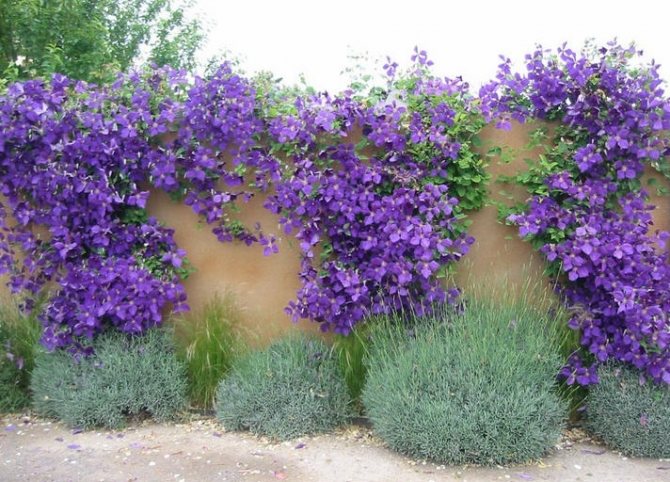
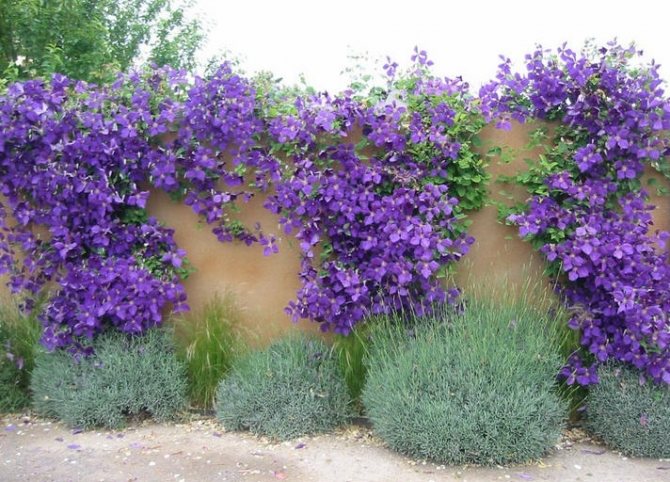
In the spring, it is necessary to free the plant from shelter as soon as the threat of night frosts has passed.
Clematis: preparing for winter
Plant preparation for wintering begins in August. It is important to carry out all activities in a timely manner so that the plant has time to prepare for the coming cold weather. How clematis winters
The following are used as the main measures for preparing for winter:
- Nitrogen fertilization has been stopped since August.
- In September, the plant is strengthened with phosphorus-potassium fertilizers. They help the shoots to emerge faster and prepare for wintering.
Pruning clematis before winter
A month before the onset of frost, the plant is pruned. Clematis, which bloom on this year’s shoots, should be fully pruned in the fall. Plants of the second year are not completely cut off, they retain shoots and buds.
How to cover clematis for the winter
Caring for clematis in the winter time consists in shelter not only from frost, but also from moisture. Therefore, the material must be dry. It is designed to protect roots and shoots from precipitation, melt water, icing.
It is important to strictly adhere to the timing of the shelter. You need to focus on the air temperature. You need to cover clematis as soon as the air becomes – 5 degrees. Most often this period falls in November. The procedure is carried out only in dry weather.
It is necessary to cover the plant as follows:
- Planks or spruce branches are laid out around the bush. The shoots are twisted and laid on the base.
- Wooden shields are laid on the shoots to create an air gap.
- An insulating layer is arranged on top, for example, a non-woven material or a film is used.
If there is no snow, you can put spruce branches or brushwood on top of the insulation.
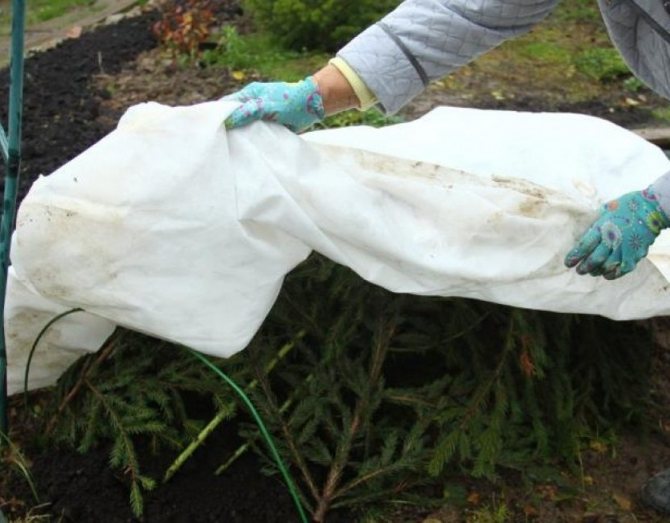

Preparation for winter
What are clematis?
Novice gardeners are afraid to grow this culture on their site, motivating their decision with the exotic origin of the flower and the lack of much experience in growing capricious plants. Meanwhile, there are many varieties of clematis for beginners. Small-flowered varieties of clematis are considered the easiest to care for. And also, the lighter the color of the flowers, the more trouble with them. Varieties with purple, violet and blue flowers are recognized as the easiest to grow.
Blue-flowered varieties are considered less moody.
Caring for these vines largely depends on the group to which they belong. The criteria for such a division were the presence of a common “ancestor”, the coincidence of the flowering period and the external similarity of plants. There are only 9 such groups, but only 4 are suitable for our climate: Integrifolia, Jacqueman, Viticella and Atragen. Clematis varieties that safely tolerate winters and are suitable for growing in the middle lane belong precisely to these groups. For more information on the classification of clematis, read our article:
- What are clematis – an overview of groups, the best varieties (photo)We figure out which clematis to plant in the garden, so as not to miscalculate.
Clematis for the Northwest: planting and care features
Northwest Russia is characterized by a cold winter period. Choose for planting varieties that bloom early. These should be undersized shrubs. Their flowering begins in July and ends in early autumn. Lianas are hardy and small flowers.
Important! The plant is planted on the sunny side, the place must be protected from the wind. The soil is loose and nutritious. In doing so, groundwater should be avoided.
Classification of clematis
Types of clematis are divided, focusing on:
| Flowering time. | There are 3 groups in total. The first includes plants that bloom in spring and early summer. The second consists of lianas, in which corollas appear twice during the summer. The appearance of the inflorescences in this case is different. The third contains varieties that delight with their bright corollas in July and August. |
| The shape, splendor and size of the flowers. | Clematis differs in shade (from pale and saturated) and method of staining (two-tone, monochromatic). Corollas can resemble bells, saucers, and stars. Gardeners plant both simple and terry clematis in the plots. |
| The need for pruning. | Timely removal of unnecessary parts entails abundant flowering, branching and the formation of new shoots. |
Lomonosovs are large and small flowered.
How does clematis reproduce?
Every gardener wants more clematis bushes, so he thinks about its reproduction. Clematis reproduces in three ways:
1. Cuttings. Reproduction of clematis by cuttings is considered the most common type of increase in its number. Cuttings should only be cut from a healthy bush so that they take root in a new place and do not hurt much.
This is best done during the swelling of the buds. Cut off one shoot and cut it into pieces – cuttings, on which there should be at least one bud.
Next, you should plant each stalk in its own dish and let it root well before planting in open ground, for which special preparations should be used.
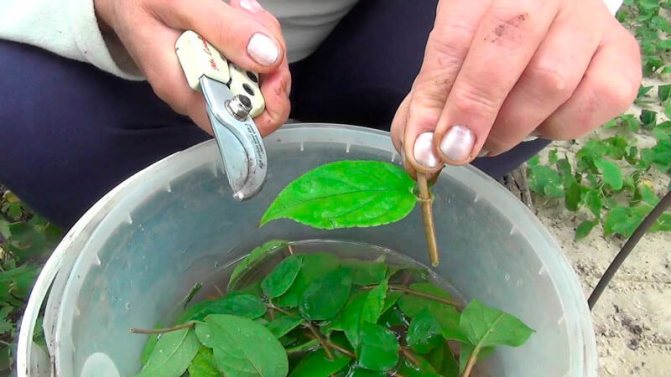
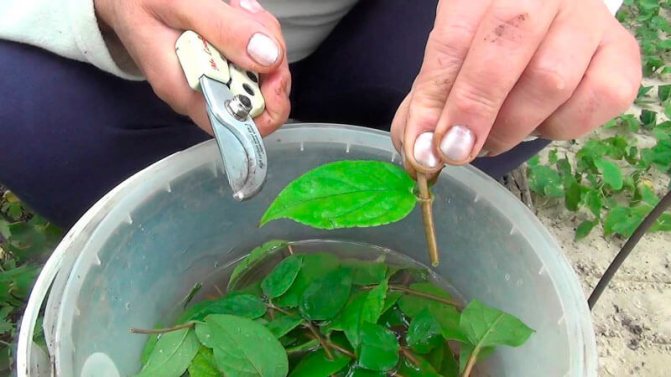
2. By dividing the bush. Reproduction in this way has one feature – the bush must be at least 4-6 years old. Older plants should be much more difficult to divide due to their strong root system.
The transplant can be done both in the spring and in the fall. Next, you should dig out a bush intended for dividing, divide it into several pieces and plant them in a new area. You can simply dig in the bush and separate the required part along with the roots.
3. Layers. This breeding method does not require large labor costs. In spring or autumn, you will have to make shallow (up to 10 cm) trenches from the bushes.
Side branches should be laid in them and covered with earth. Layers must be watered abundantly, preventing them from drying out in the summer heat.
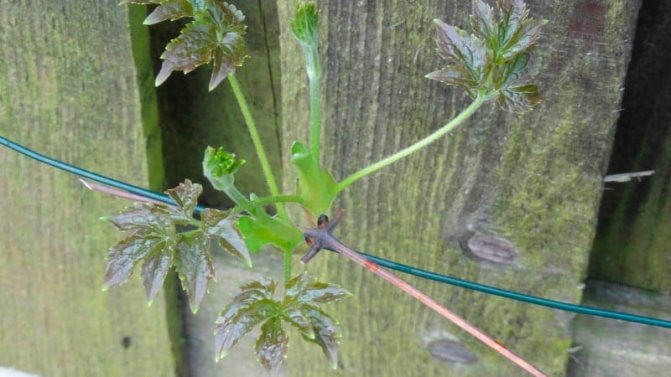
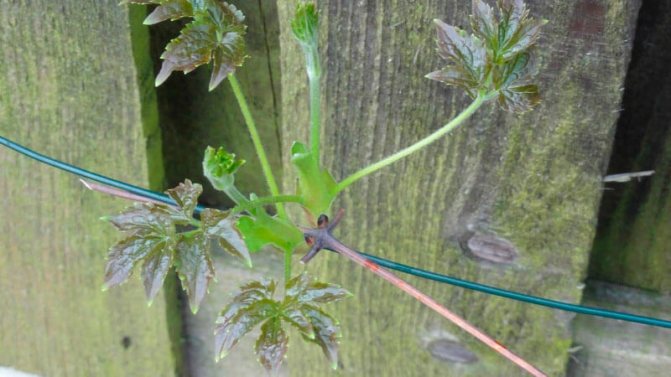
The seedlings obtained from the cuttings can be transferred to a new place of growth only after a year.
I must say that it is not recommended to propagate large-flowered hybrids by seeds, new seedlings do not retain the qualities of the mother plant. The most popular way of propagating clematis by cuttings.
Clematis variety Asao
Main characteristics
- Early flowering and frost-resistant variety.
- The flowers are pale pink in color, with a white stripe in the center of the bud.
- The stamens are light yellow.
- The height of the liana reaches 2-3 m.
- The buds bloom on the shoots of the current and previous year.
- The variety blooms from early May to late September.
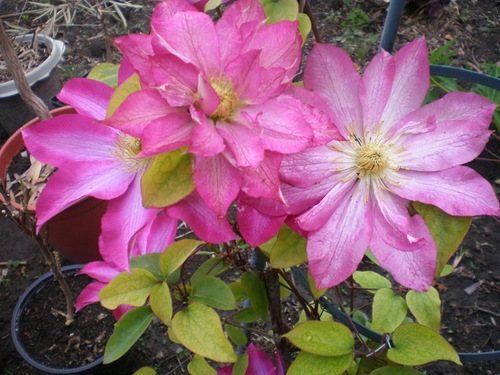
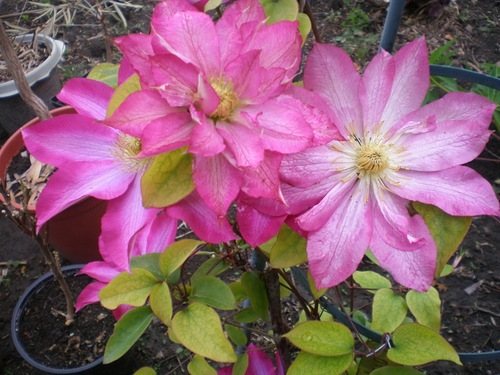
Planting and care
- The variety is suitable for facade landscaping and green hedging.
- For cultivation, it is best to choose areas of the territory with little shading and the presence of loose and fertile soil. Based on this, ordinary chernozems and sandy loam fertilized soils are best suited.
- For propagation of the variety, layering must be used. Planting of cuttings is carried out in mid-April in fertilized planting pits.
- Planting pits should be 55 cm deep and 60 cm wide. For quick survival and further growth, it is recommended to add 10-11 kg to the pit. compost and 25-30 g of nitroammofoska.
- The variety cannot develop normally without the presence of the required amount of moisture and nutrients in the soil. Therefore, you need to water clematis twice a week at the rate of 10 liters. water per plant.
- It is recommended to feed the variety in early May with a solution of chicken manure (1 liter of droppings per 10 liters of water). Under one bush, you need to add 5 liters. prepared solution. In the future, for rapid growth and abundant flowering, it is necessary during May to carry out two spraying with Vympel (15 ml and 8-9 liters of water) with an interval of 7-8 days.
- During the entire flowering period, faded flowers and damaged shoots are removed. In early November, the shoots are shortened to 1 m in length.
- In autumn, the soil around the bushes is insulated with sawdust or sunflower husk.
Clematis variety “Mrs. N. Thompson “
Main characteristics
- The flowers are purple, with a stripe in the center of the bud of bright red color.
- The diameter of the flowers is 18-20 cm.
- Plant height is 2.5-3 m.
- The variety blooms throughout June – September.
- Flowers are formed on current and last year’s shoots.
- Plants are highly resistant to diseases and low temperatures.
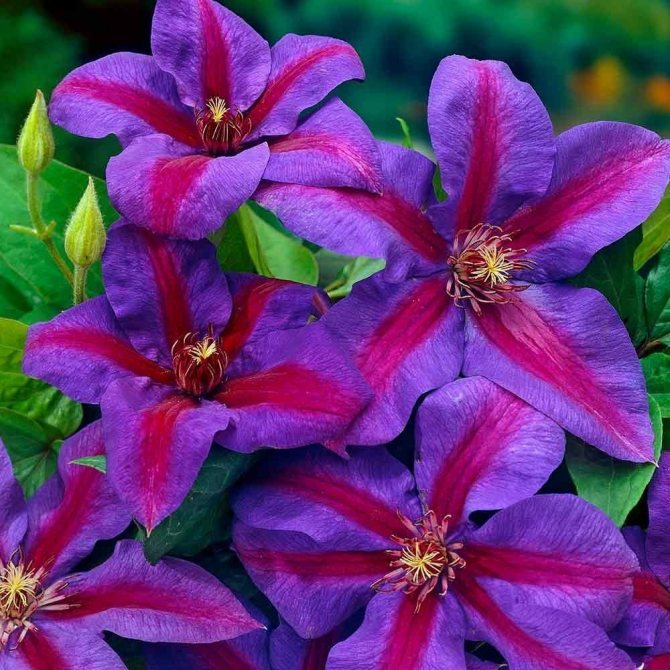
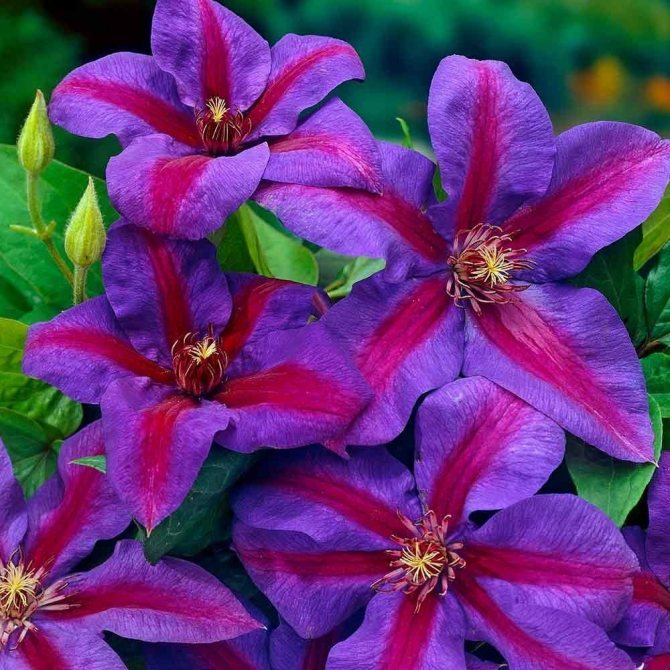
Planting and care
- The variety is perfect for landscaping various areas and building facades.
- Plants of the aforementioned variety can be grown both outdoors and in containers. The most suitable soil for this variety is sandy loam soil with a sufficient amount of organic fertilizers.
- Planting of cuttings can be done both in spring and autumn.
- The landing pattern is 0.9 x 1.2 m.
- The fertilization system consists of the following activities:5-7 days before planting, the soil layers are dug up and fertilized with rotted manure at the rate of 8-9 kg. per 1 m2.
- 7 kg are added to the planting pits. compost and 30-35 g of nitroammofoska.
- at the end of April, plants are sprayed with a solution of urea (10 g per 12 liters of water).
- at the beginning of May, spraying with liquid fertilizer Potassium Humate (15 ml per 12 liters of water) is carried out.
- Plants need a garter.
- Plants should be watered at least once a week. For one clematis, you need to spend 15-18 liters. water.
- After each wave of flowering, damaged shoots and faded flowers are cut out. Shoots shortened to 1 m in height leave for wintering.
- Before leaving for the winter, the bushes are insulated with roofing material, sawdust or dry peat.
List of clematis varieties used for planting in the Moscow region
1) Ville de Lyonrefers to the rather old and therefore time-tested varieties of clematis. Bred by French breeders, it, meanwhile, has a character resistant to northern winters and can safely withstand low temperatures without shelter. In addition, this variety is distinguished by its ability to resist infection by fungal infections. During the flowering period, shoots of clematis varieties “Ville de Lyon” are covered with large flowers of a carmine shade of red, whose diameter can be 15 cm. The petal plates are colored non-uniformly and covered with feathery strokes of a lighter pink color. The core of the flower is decorated with pale yellow fluffy stamens. The height of the shoots is often 4 m. The optimal time for planting clematis of this variety is spring or autumn. It is important that at the time of landing there are no sharp night drops in temperature.
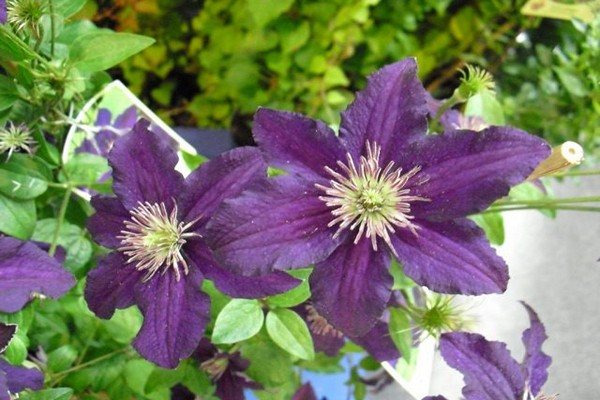

2) Gipsy Queen– a variety of clematis of Polish origin. Its colors are characterized by a deep violet color with noble purple notes. They consist, as a rule, of 4 or 6 petals, markedly separated, collected in the form of an umbrella. Their diameter can reach 18 cm, although there are also smaller specimens (11 cm). The core is decorated with purple-scarlet stamens. The beginning of the flowering period for clematis “Gypsy Queen” falls in mid-July, the final – in the first days of October, before the frost comes. Flowers form on new shoots: up to 20 flowers can open on each stem. This variety is distinguished by a high degree of resistance to infectious diseases and low temperatures. It can be grown in regions where frosts down to -30 degrees occur. Gypsy Queen is characterized by a lush bloom, regardless of the the bush is located in the sun or in partial shade. The color of the flowers does not suffer from exposure to bright sunlight. However, full shade and constant exposure to the sun are still undesirable. Stagnation of moisture in the soil and its waterlogging are dangerous for the health of clematis “Gypsy Queen”. When choosing a site for planting clematis, it is recommended to avoid placing it too close to the walls of buildings and high fences, since the rainwater flowing from them will flood the plants. The optimal spacing between plantings and walls is 20 to 35 cm. When choosing a site for planting clematis, it is recommended to avoid placing it too close to the walls of buildings and high fences, since the rainwater flowing from them will flood the plants. The optimal spacing between plantings and walls is 20 to 35 cm. When choosing a site for planting clematis, it is recommended to avoid placing it too close to the walls of buildings and high fences, since the rainwater flowing from them will flood the plants. The optimal spacing between plantings and walls is 20 to 35 cm.
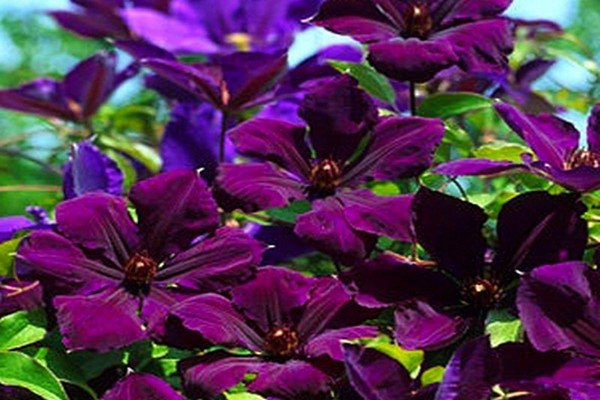
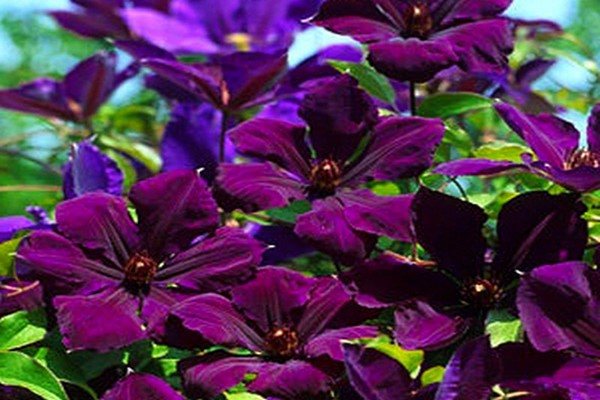
3) Another French hybrid among clematis is called “Red Cardinal” (Rouge Cardinal)… This variety has been repeatedly recognized as one of the best at international exhibitions. As the name of the variety suggests, the flowers of this variety have a noble burgundy color, reminiscent of the cardinal’s mantle. Against the background of the petals of a saturated shade, light yellow or fine white stamens look contrasting. The surface of the wide petals is covered with longitudinal stripes, and wavy edges are also characteristic of them. An important point in caring for flowering vines is to create support for them. It is necessary to tie up new shoots in a timely manner to the supporting structures so that the clematis bush gradually takes on a certain shape. In addition, the supports will protect the shoots from damage from strong winds. This is especially important for varieties with high growth rates of shoots – 3-5 new shoots can appear during the summer months, requiring a garter. The choice of soil is very important for the successful growth and development of clematis. The best option for growing them will be fertile loam, fertilized with nutrient mixtures. Soils with a high level of acidity, heavy and saline soils are categorically not suitable for planting flowering vines. Areas with high groundwater levels should be avoided.
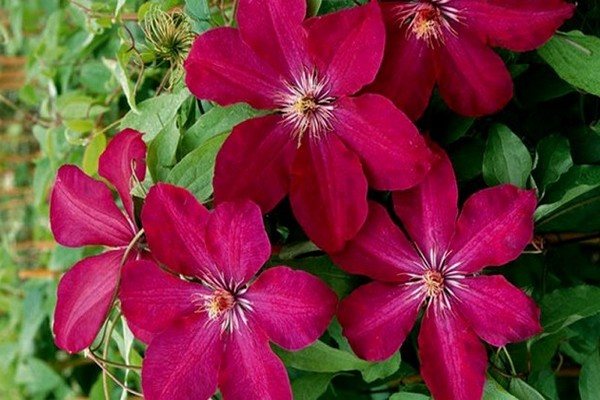
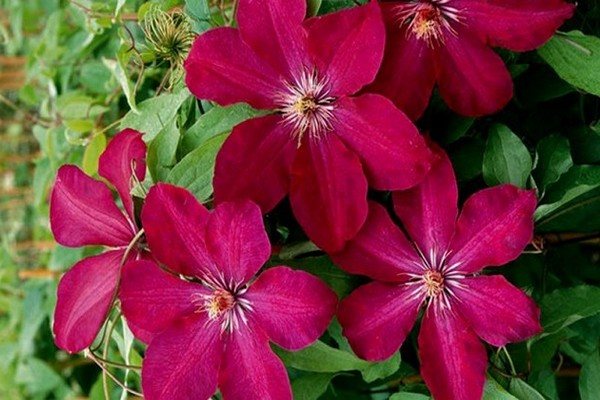
4) Polish breeders have presented the world with another of the most frost-resistant hybrid varieties of clematis, which has been successful for half a century, since the mid-60s. Its name is “General Sikorski”… This variety is resistant not only to the effects of low temperatures, but also to infectious diseases of fungal origin. During the flowering period, the vines of this variety are covered with blue-violet flowers, in the middle of which a yellow bundle of stamens glows spectacularly. Shoots of clematis “General Sikorsky” equally successfully climb artificial and natural supports, for example, tree trunks, twine around bushes, climb hedges. This type of clematis is also suitable for growing in pots and containers. Clematis varieties “General Sikorsky” feel great in partial shade, but bright sunlight and heat are destructive for them. Under the influence of direct rays of the sun, the color of the petals fades, and the flowers themselves quickly wither. You can prolong flowering and strengthen the health of clematis bushes with the help of dressings. Immediately after planting in open ground, the seedling needs abundant watering, and nutrients can be added to the soil mixture placed in the planting holes. Adult clematis bushes also need to be fed. At the beginning of the growing season, nitrogenous fertilizing is introduced, thanks to which the plant grows green mass. On the eve of flowering, the soil should be fertilized with phosphorus-potassium complexes, wood ash. But with organic fertilizers, you need to be careful, especially in the case of processing young plants. In a concentrated form, they can harm the not yet mature clematis bushes and even destroy them. At the beginning of the growing season, nitrogenous fertilizing is introduced, thanks to which the plant grows green mass. On the eve of flowering, the soil should be fertilized with phosphorus-potassium complexes, wood ash. But with organic fertilizers, you need to be careful, especially in the case of processing young plants. In a concentrated form, they can harm the not yet mature clematis bushes and even destroy them. At the beginning of the growing season, nitrogenous fertilizing is introduced, thanks to which the plant grows green mass. On the eve of flowering, the soil should be fertilized with phosphorus-potassium complexes, wood ash. But with organic fertilizers, you need to be careful, especially in the case of processing young plants. In a concentrated form, they can harm the not yet mature clematis bushes and even destroy them.
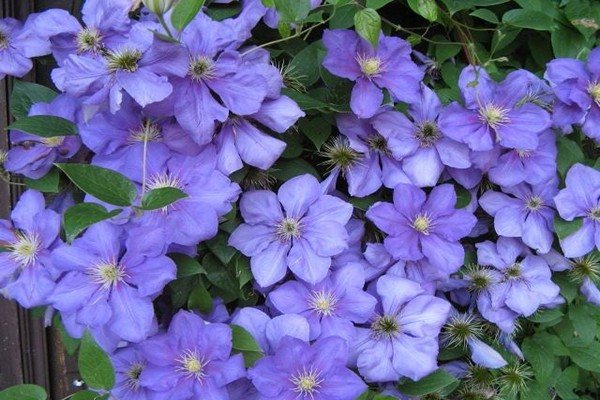
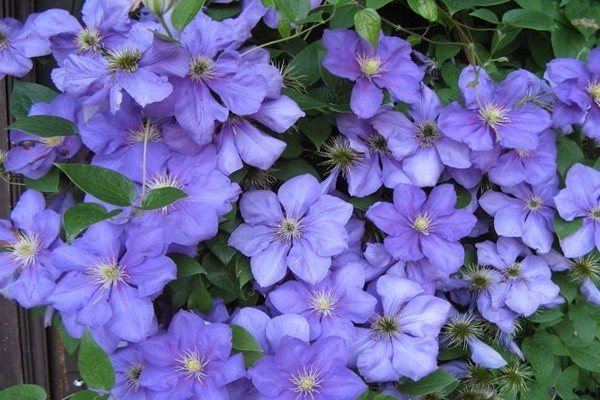
5) Clematis varieties “Luther Burbank” (Luther Burbank)have long been garden classics. No wonder they are named after the founder of American breeding science. This variety has an impressive appearance: large purple flowers consist of slightly pointed elliptical petals, and in the center are decorated with large yellow-white tufts of stamens. The slightly corrugated surface of the petals and the lighter shades covering it give the flowers an even more dramatic look. The diameter of flowers sometimes reaches 24 cm, about 12 flowers are formed on each liana. Stems of clematis “Luther Burbank” can grow up to 5 m, only 1 bush of clematis of this variety accounts for about 10 vines. Thus, with proper care, clematis of this variety can create a real blooming carpet that grows widely and tightly covers the walls of buildings and fences. For the successful development of flowering vines, it is important to carry out the deepening procedure every year. For this purpose, sprinkle the root of the vines with earth.
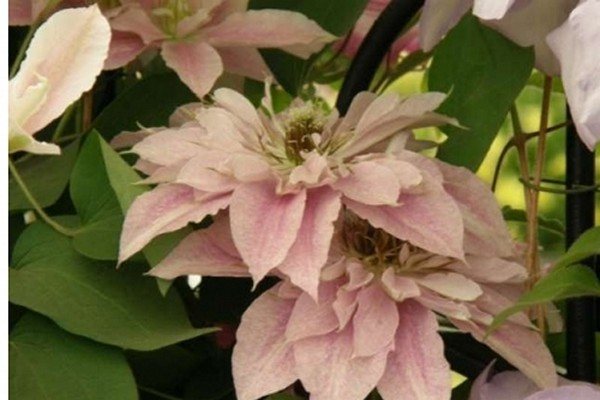
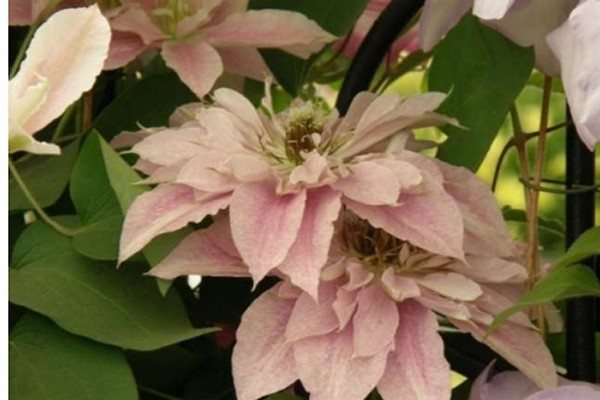
6) “Nikolai Rubtsov” is one of the clematis varieties that do not tolerate exposure to bright sunlight. The reason for this lies in the delicate color of the elliptical slightly corrugated petals – their surface has a delicate purple hue, diluted with white strokes. When planting clematis of this variety, it is recommended to avoid open areas so that the color of the petals does not fade under the influence of the sun’s rays. The Nikolay Rubtsov variety is resistant to low temperatures, but cannot boast of a long flowering period – the opened buds remain on the shoots for no more than a month, and then wither and crumble. This variety is characterized by the formation of lush foliage: the shoots grow widely and intertwine with each other.
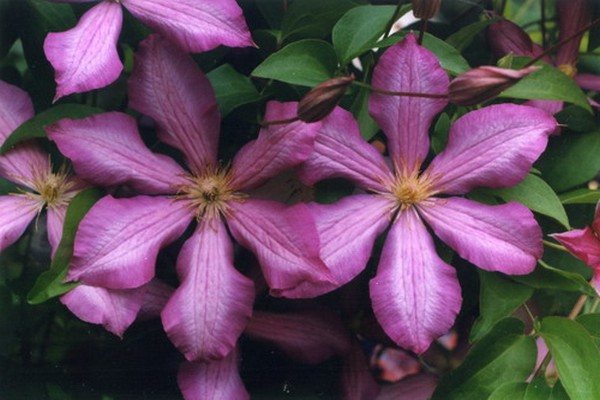
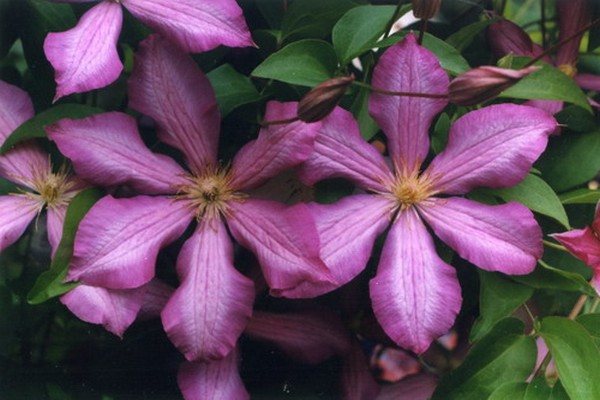
7) Another of the clematis varieties from Polish breeders – a recognized favorite among purple flowers, clematis “Niobe”… Its solemn and slightly gloomy color fully corresponds to the name received from one of the notorious heroines of ancient Greek mythology. According to tradition, the large queen Niobe provoked the wrath of the god Apollo and his sister Artemis by insulting their mother. As punishment, the gods killed all of her sons and daughters. The dark red flowers of “Niobe” evoke associations with the color of blood, as well as purpura, which has long been associated with the royal status. The buds of this variety are almost black in color, which also reminds of mourning. As they mature, they brighten, becoming purple. The pointed shape of the petals resembles the arrows of Apollo and Artemis, which killed 14 children of Queen Niobe. This variety of clematis tends to grow widely – the width of the bush can be about a meter with a shoot height of up to 2.5 m. Despite the frost-resistant nature of the Niobe variety, experts do not recommend leaving it without shelter for the winter. It is better to take care of warming the branches of flowering creepers and wrap them tightly to prevent frostbite.
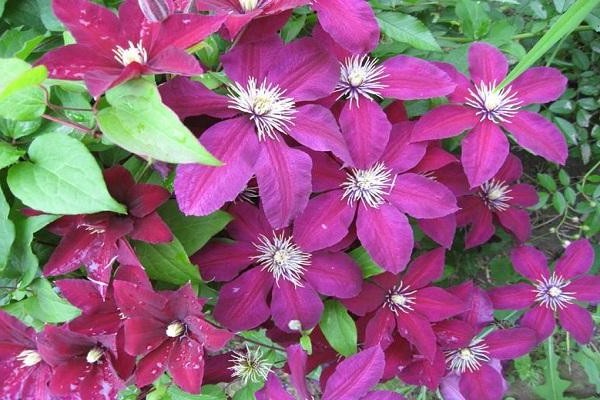
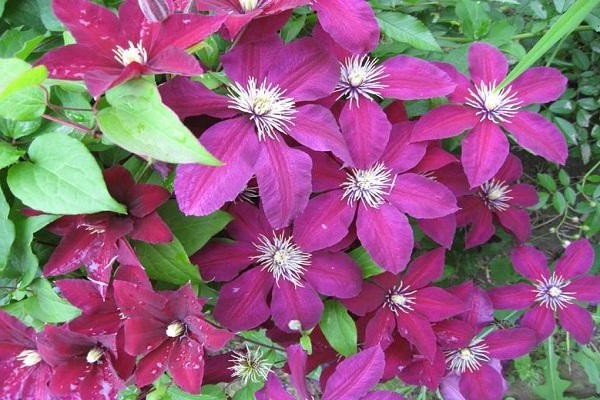
![]()
 The French breeding classics of clematis varieties include “Nelly Moser”with an unusual flower structure. Its petals are staggered, in fact, forming two rows, which visually makes them more luxuriant. Coloring “Nelly Moser” is also very effective and unusual: the snow-white surface of the petals in the center is intersected by a wide flat saturated pink color. Like many frost-resistant clematis, representatives of this variety do not like heat and bright sun, under the influence of which their petals burn out and lose their interesting color. In dry periods, it is necessary to water the plantings of clematis of this variety weekly. After each watering, loosening and weeding is required to remove weeds from the site. The advantage of “Nelly Moser” is the long flowering period: in May, the first buds bloom on last year’s shoots, in September the shoots of the current season are covered with flowers.
The French breeding classics of clematis varieties include “Nelly Moser”with an unusual flower structure. Its petals are staggered, in fact, forming two rows, which visually makes them more luxuriant. Coloring “Nelly Moser” is also very effective and unusual: the snow-white surface of the petals in the center is intersected by a wide flat saturated pink color. Like many frost-resistant clematis, representatives of this variety do not like heat and bright sun, under the influence of which their petals burn out and lose their interesting color. In dry periods, it is necessary to water the plantings of clematis of this variety weekly. After each watering, loosening and weeding is required to remove weeds from the site. The advantage of “Nelly Moser” is the long flowering period: in May, the first buds bloom on last year’s shoots, in September the shoots of the current season are covered with flowers.
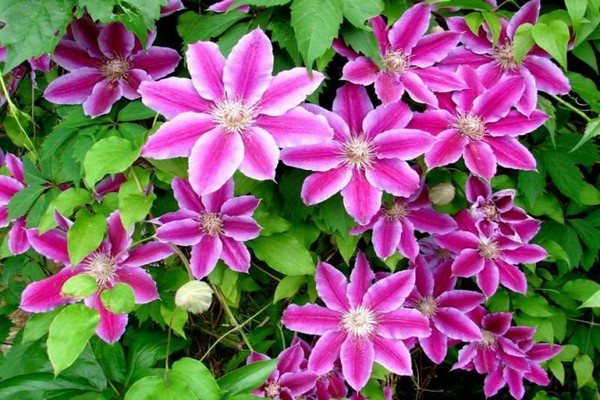
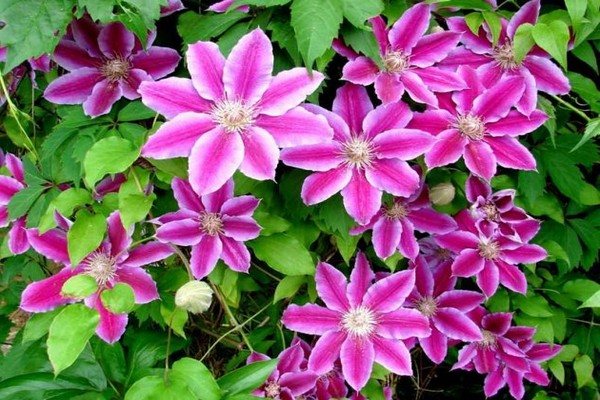
9) In the Crimean Nikitsky Botanical Garden, a variety of clematis was bred more than 50 years ago, dedicated to the world famous Maya Plisetskaya. Its name is natural – “Ballerina” (Balerina)like no other match these dainty whites. This is one of the most beautiful clematis varieties. The petals are snow-white and have an elliptical shape and a pointed top. The core is decorated with a lush rosette of crimson stamens, contrasting against the sparkling white background. The diameter of the flowers is about 15 cm. The shoots of “Ballerina” clematis grow up to 3 m in height and are covered with luxurious white flowers twice during the season. The first wave of flowering occurs in June, when the buds bloom on the old stems of the previous year. The beginning of the second wave dates back to July – this time the shoots of the current season are flowering. In order to get a long and abundant flowering of clematis, it is important to take care of the quick and safe adaptation of the seedling in a new place. To do this, before planting it in open ground, the roots should be placed in a solution that stimulates their growth and left for several hours. The planting holes must be prepared in advance: a drainage layer must be placed on the bottom of the holes, consisting of pebbles, rubble or broken brick. Then a nutritious soil mixture is poured over the drainage layer, forming a hill about 5 cm high. A seedling is placed on its top, while its root system must be carefully straightened.
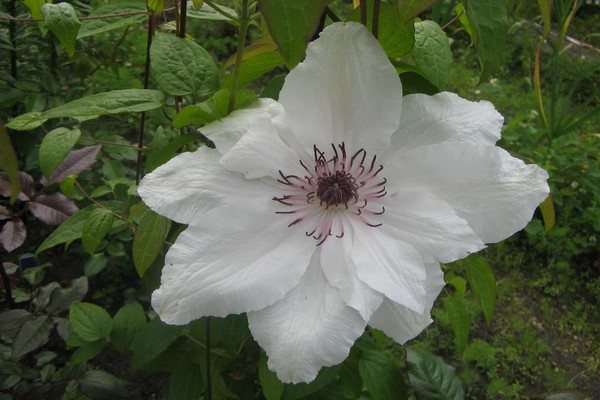
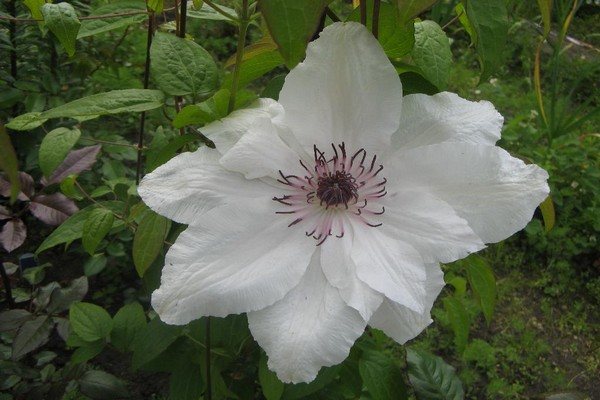
10) Unlike most hybrid clematis varieties , the Nadezhda varietywas born thanks to the efforts of an amateur gardener, not scientists. The creator of this variety bred it in the 60s and dedicated it to her sister, whose name is immortalized in the name of the variety. The clematis variety “Nadezhda” has established itself as one of the best two-color hybrids, combining high decorative qualities and a character resistant to unfavorable weather. Its flowering period lasts until the first autumn frosts. In the process, his vines are covered with large pale pink flowers, whose leaf blades are decorated with bright purple longitudinal stripes. The core is crowned with golden yellow fluffy stamens. To ensure lush flowering in the coming season, clematis bushes “Nadezhda” must be cut during preparation for wintering – in October or in the first days of November.
